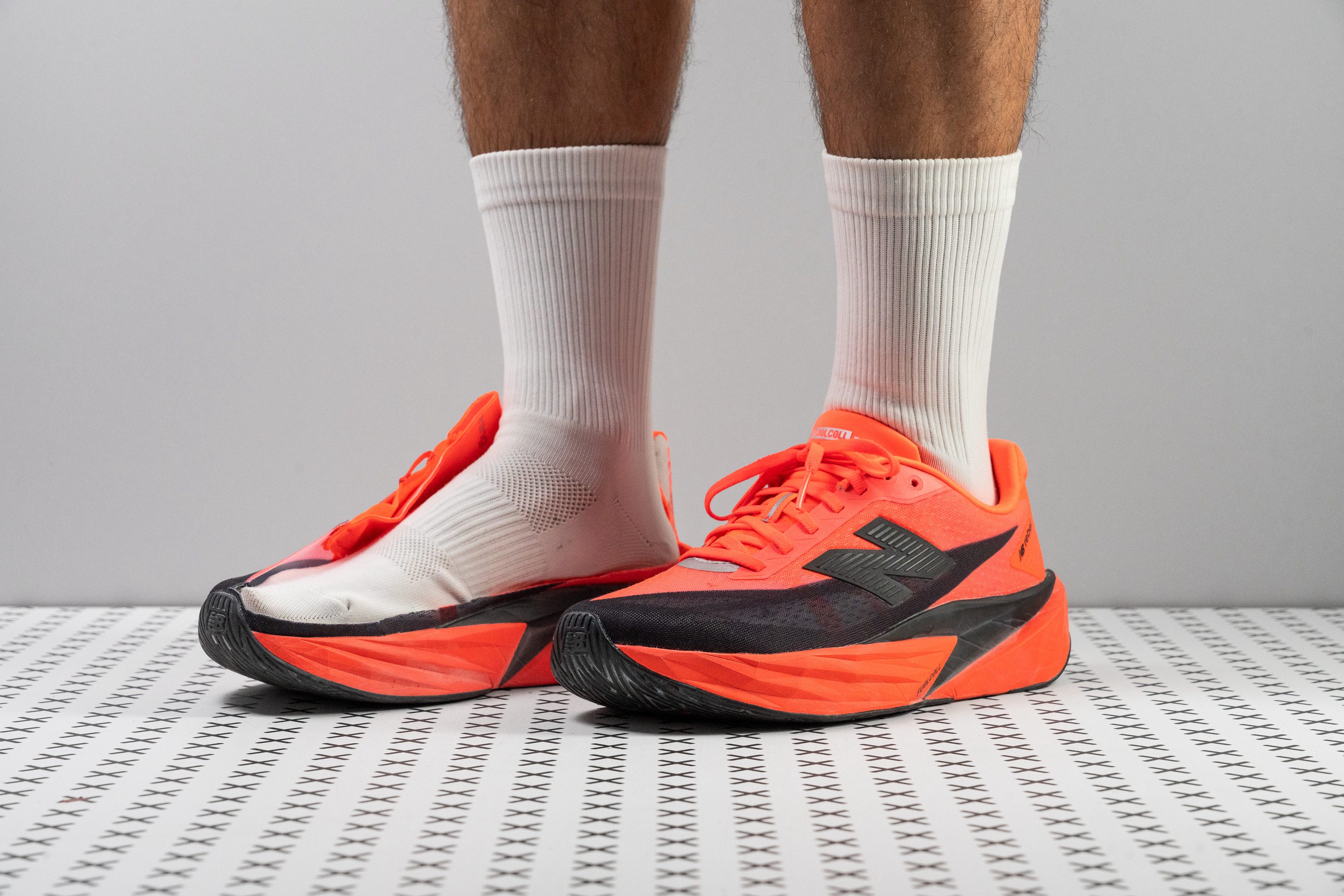Our verdict
- Top pick in best New Balance running shoes
Pros
- Lightweight build
- Cloud-soft FuelCell foam
- Fixes all issues from v4
- Maintains the same price from v4
- Handles easy runs and tempo sessions
- Top pick for midfoot strikers
- Still flexible and fun
- Improved fit overall
Cons
- Runs warm on hot summer days
- Upper durability is a concern
- Traction could be better
Audience verdict
- Top 11% in road running shoes
- Top 7% in New Balance running shoes
- Top 10% most popular running shoes
Comparison
The most similar running shoes compared
+ + Add a shoe | |||||
|---|---|---|---|---|---|
| Audience score | 91 Superb! | 92 Superb! | 79 Good! | 70 Bad! | |
| Price | $140 | $125 | $85 | $70 | |
| Pace | Daily runningTempo | Daily running | Daily running | Daily running | |
| Shock absorption | High | High | Moderate | Low | |
| Energy return | Moderate | Moderate | Moderate | Moderate | |
| Traction | High | Moderate | High | Moderate | |
| Arch support | Neutral | Neutral | Neutral | Neutral | |
| Weight lab Weight brand | 7.8 oz / 220g 7.9 oz / 225g | 10.1 oz / 285g 9.7 oz / 275g | 8.4 oz / 238g 9.1 oz / 258g | 8.5 oz / 242g 8.7 oz / 246g | |
| Lightweight | ✓ | ✗ | ✓ | ✓ | |
| Drop lab Drop brand | 6.3 mm 6.0 mm | 6.5 mm 6.0 mm | 7.2 mm 8.0 mm | 7.7 mm 8.0 mm | |
| Strike pattern | Mid/forefoot | Mid/forefoot | Mid/forefoot | Mid/forefoot | |
| Size | True to size | True to size | Slightly small | True to size | |
| Midsole softness | Soft | Soft | Balanced | Soft | |
| Difference in midsole softness in cold | Small | Normal | Small | Big | |
| Toebox durability | Bad | Decent | - | Bad | |
| Heel padding durability | Good | Bad | - | Bad | |
| Outsole durability | Good | Good | - | Good | |
| Breathability | Moderate | Moderate | Warm | Moderate | |
| Width / fit | Medium | Narrow | Narrow | Medium | |
| Toebox width | Medium | Medium | - | Medium | |
| Stiffness | Moderate | Moderate | Moderate | Flexible | |
| Torsional rigidity | Flexible | Stiff | Flexible | Flexible | |
| Heel counter stiffness | Moderate | Moderate | Flexible | Flexible | |
| Rocker | ✓ | ✓ | ✗ | ✗ | |
| Heel lab Heel brand | 33.0 mm 35.0 mm | 34.1 mm 38.0 mm | 32.2 mm | 28.1 mm | |
| Forefoot lab Forefoot brand | 26.7 mm 29.0 mm | 27.6 mm 32.0 mm | 25.0 mm | 20.4 mm | |
| Widths available | NormalWide | Normal | NormalWideX-Wide | NarrowNormalWideX-Wide | |
| Orthotic friendly | ✓ | ✓ | ✓ | ✓ | |
| Season | All seasons | All seasons | Winter | All seasons | |
| Removable insole | ✓ | ✓ | ✓ | ✓ | |
| Ranking | #32 Top 9% | #7 Top 2% | #322 Bottom 13% | #366 Bottom 1% | |
| Popularity | #34 Top 10% | #269 Bottom 27% | #170 Top 46% | #17 Top 5% |
Who should buy
We found that the New Balance FuelCell Rebel v5 is a perfect match for:
- Runners who gave the Rebel v4 a try but couldn’t get past the short tongue or irritating heel. Well, we found that both issues are now fully resolved.
- Anyone after a feather-light, joy-filled shoe that works for everything from daily runs to fast tempo runs.
- Forefoot and midfoot strikers who dislike maximalist shoes and prefer a grounded, ultra-flexible ride that keeps them connected to the road.
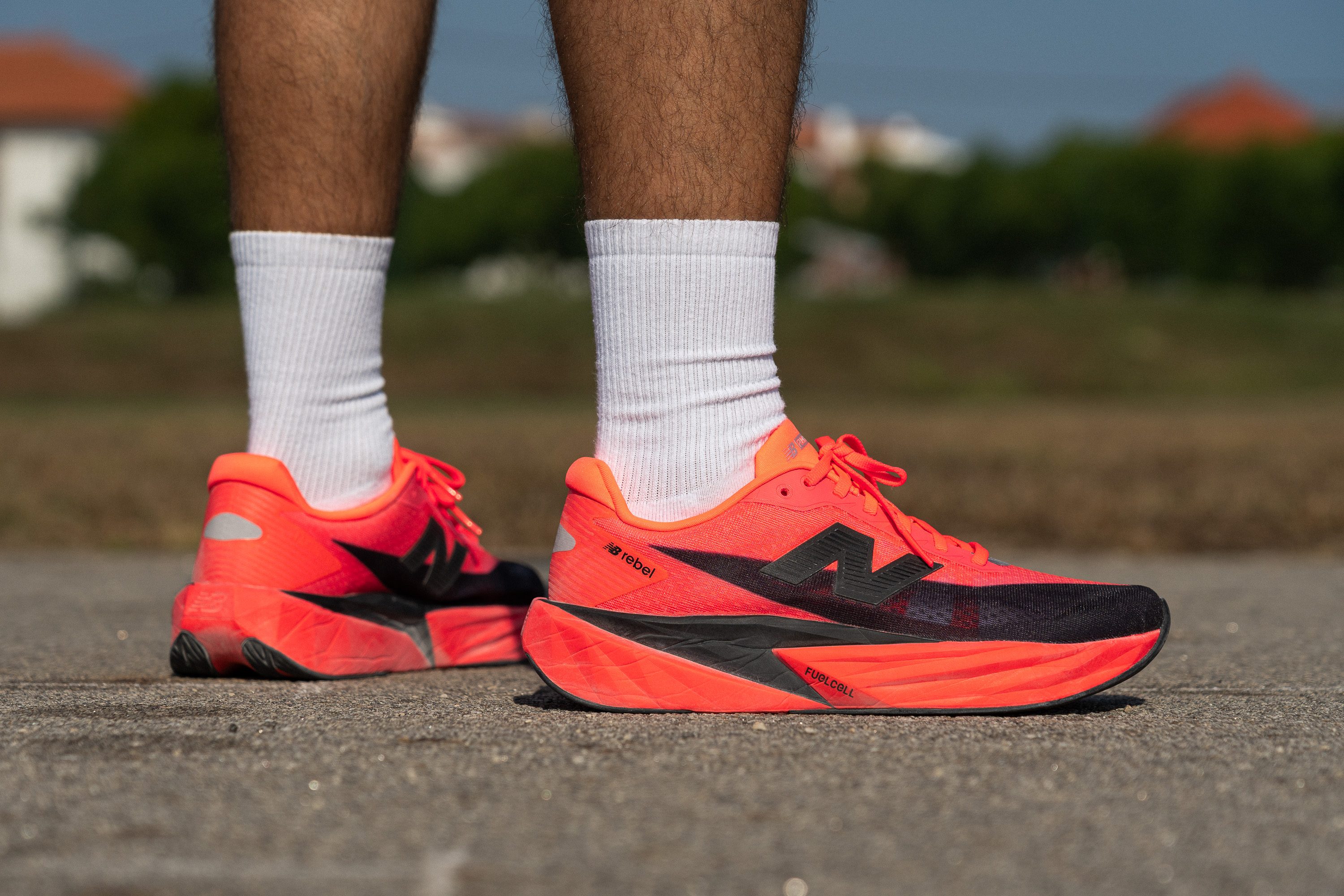
Who should NOT buy
If you're chasing maximum bounce, we believe the Rebel v5 isn’t the best choice. In our lab, shoes like the Adidas Adizero EVO SL or Adios 9 delivered better energy return—making them better suited for tempo runs and longer sessions.
Additionally, we think the Rebel v5 struggles in wet conditions or dirt roads due to its slippery outsole. Based on our tests, the ASICS Noosa Tri 16 makes a stronger pick, as it shares the same lightweight DNA but adds better traction.
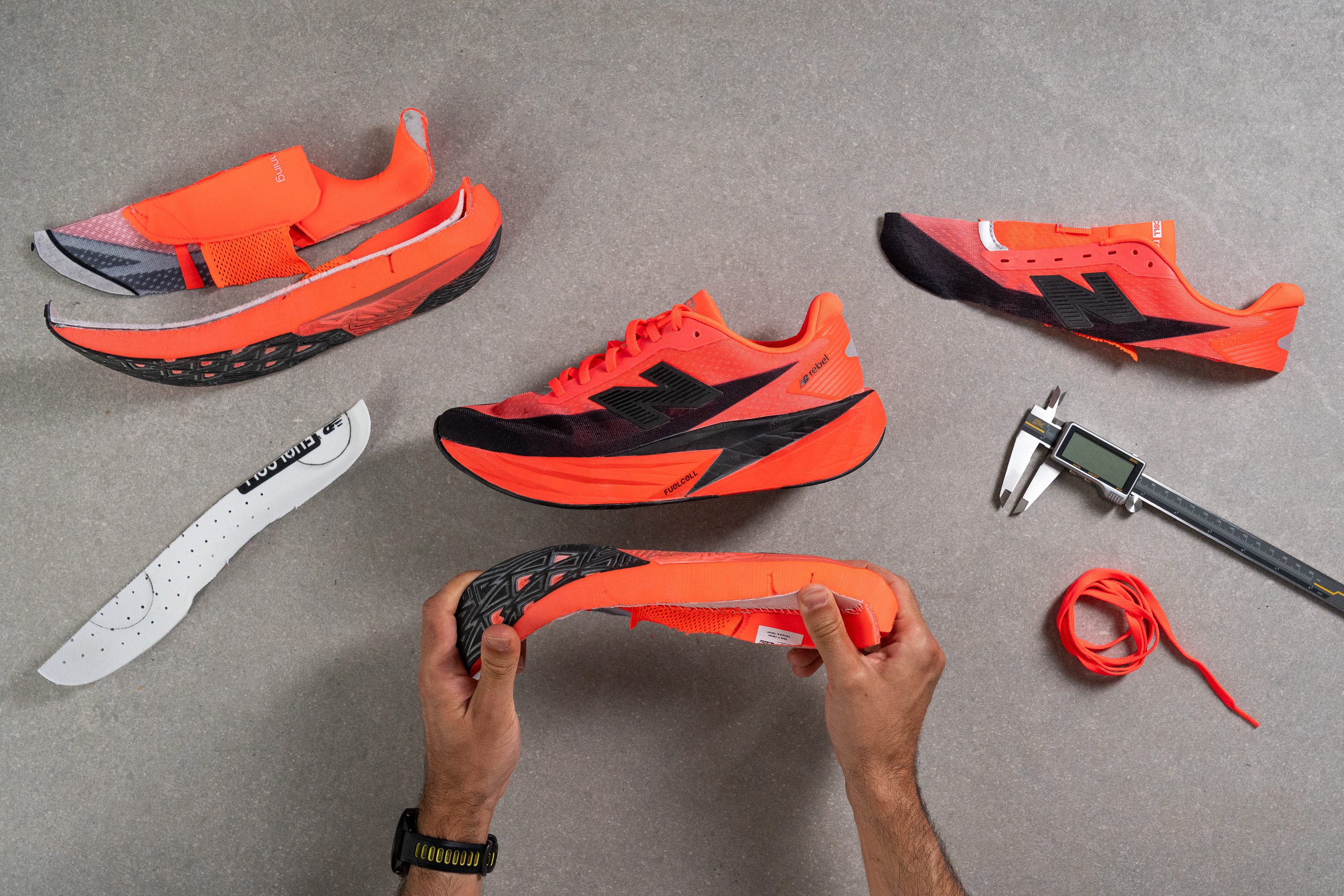
Cushioning
Shock absorption
The Rebel v5 may not reach the towering height of a maximalist shoe like the HOKA Clifton 10, but its shock absorption is truly impressive in the heel with a standout 145 SA. New Balance reworked the foam to create a softer ride, effectively enhancing its comfort underfoot.
The forefoot has also improved over the previous version, now measuring 105 SA. While that figure is closer to average, runners who appreciate the usual Rebel’s ground-connected feel will likely welcome the update.
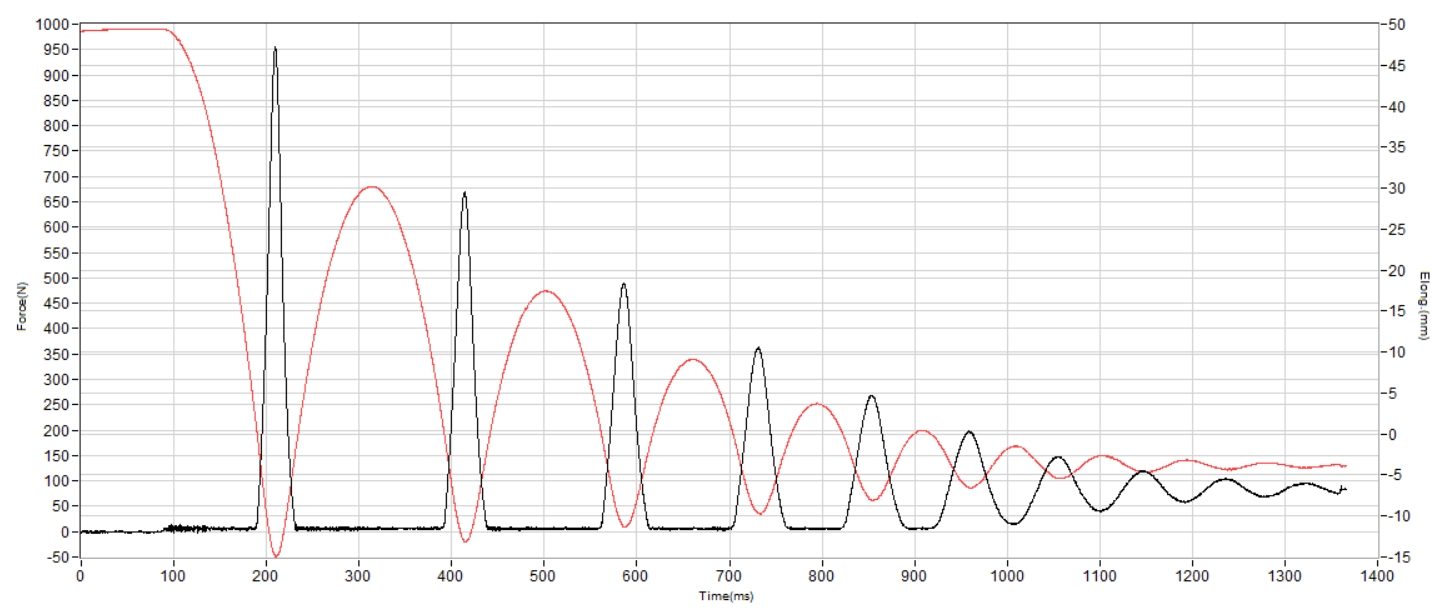
| FuelCell Rebel v5 | 145 SA |
| Average | 129 SA |
Energy return
While not alarming enough to raise red flags or become a dealbreaker, it’s still disappointing to see a slight dip in energy return in the Rebel v5’s heel: 59.8% compared to the 63.1% recorded in version 4.
On the bright side, the forefoot improves, confirming that the shoe is really responsive for midfoot and forefoot strikers. We measured a solid 67.3% here, which feels especially impressive considering the shoe’s price point.
| FuelCell Rebel v5 | 59.8% |
| Average | 58.5% |
Heel stack
The Rebel continues its steady rise in stack height, something that comes as no surprise for us. It’s no longer the low-to-the-ground shoe we saw in version 2, now reaching 33.0 mm in the heel.
But the FuelCell foam remains ultra-soft and compresses quickly under pressure. This creates a well-balanced blend of cushioning and subtle ground feel, a combination that few shoes on the market manage to pull off.
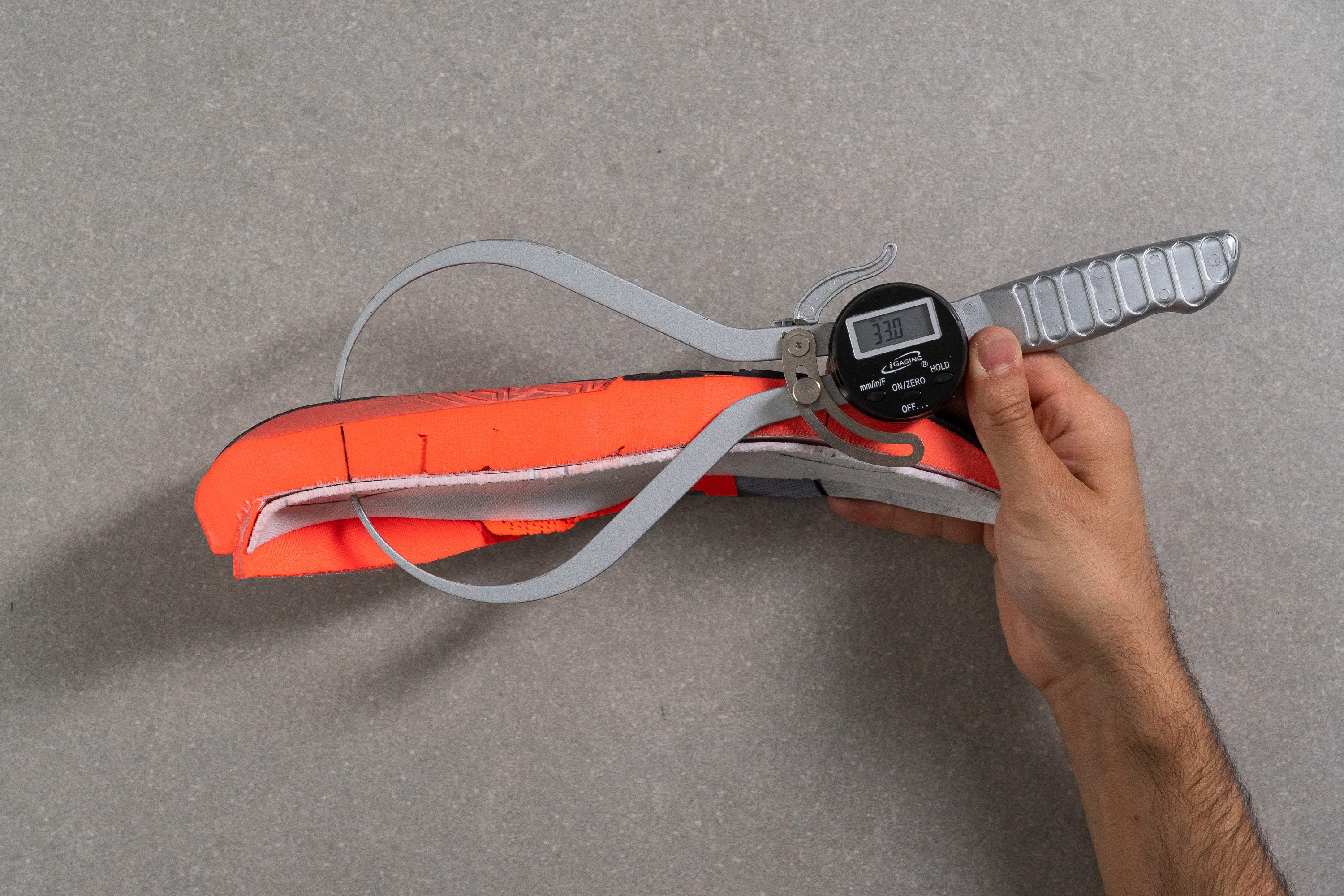
| FuelCell Rebel v5 | 33.0 mm |
| Average | 34.8 mm |
Forefoot stack
One of the things we noticed during our Rebel v4 lab review was the unexpectedly low forefoot stack at 21.5 mm, which left most forefoot strikers too close to the ground for a multi-purpose daily trainer.
That was due to its unusual midsole shape with a thick midfoot zone, but that design is gone. The Rebel v5 now has a 26.7 mm forefoot, better matched with the heel and offering a more long-run-ready setup.
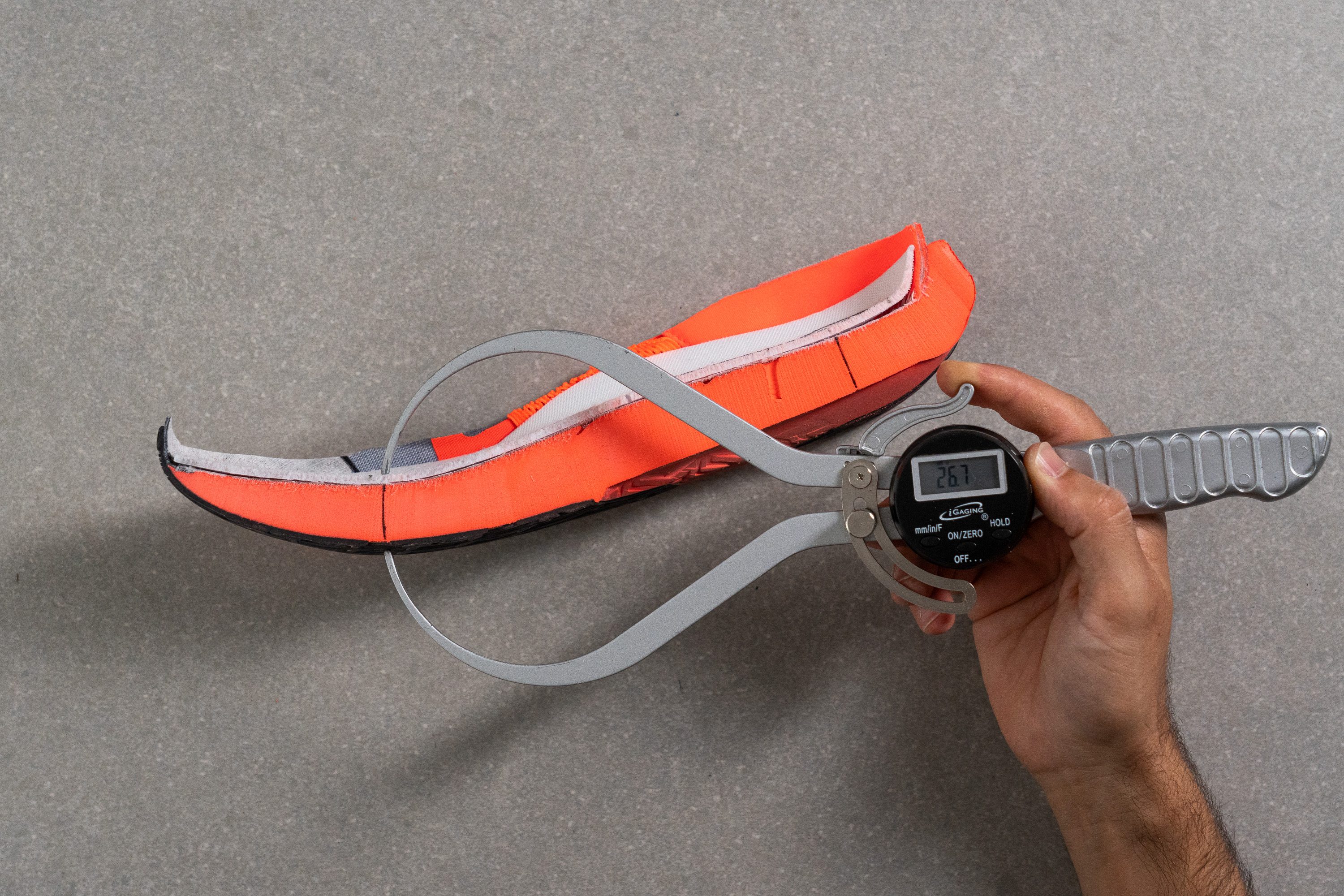
| FuelCell Rebel v5 | 26.7 mm |
| Average | 26.2 mm |
Drop
Most daily trainers stick to an 8 or 10 mm drop, but New Balance often leans toward more moderate setups. The Rebel follows that trend with a stated 6 mm drop and a measured 6.3 mm, remarkably close to spec.
This design suits midfoot strikers especially well, yet it still works comfortably for a wide range of runners.
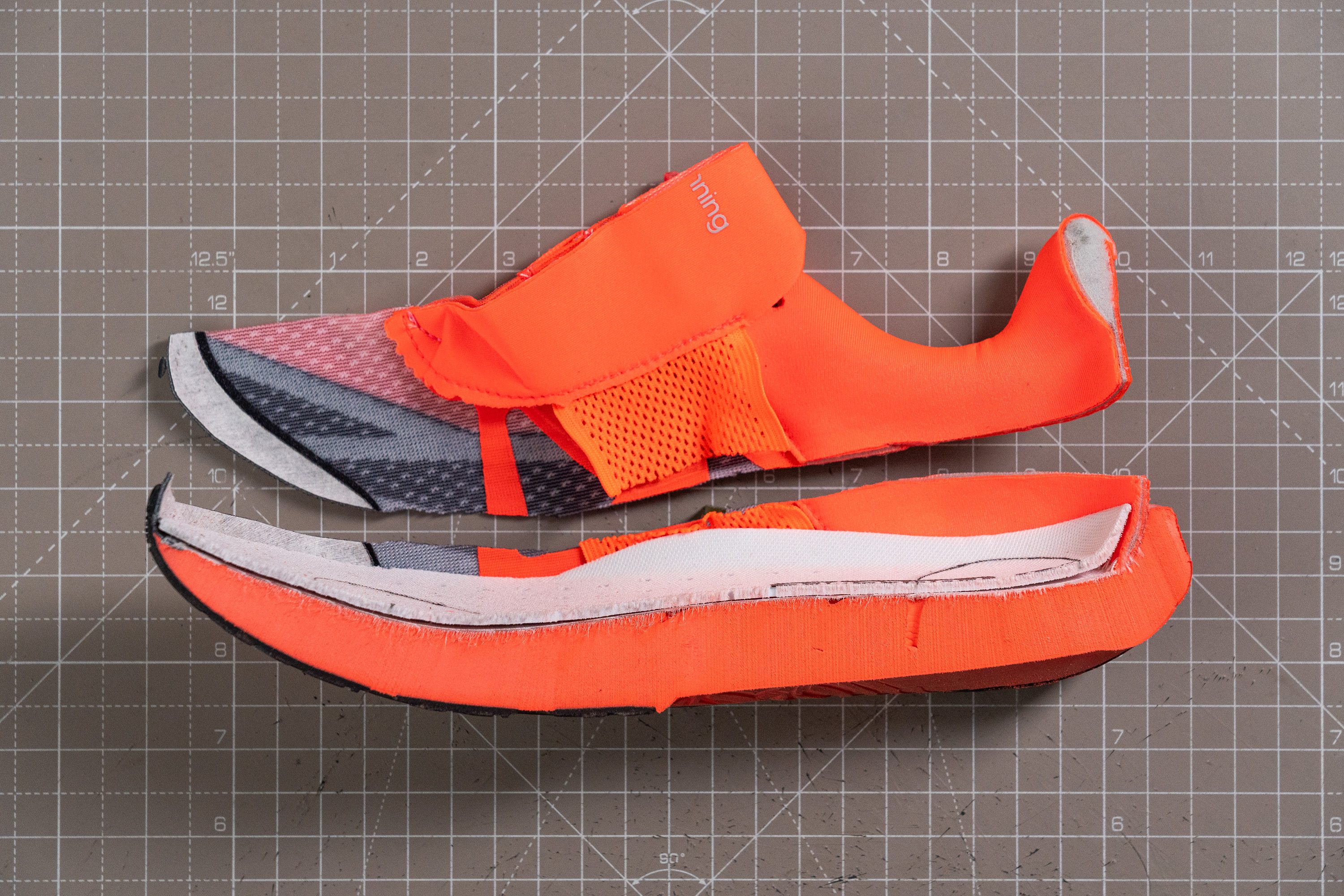
| FuelCell Rebel v5 | 6.3 mm |
| Average | 8.6 mm |
Midsole softness
New Balance continues to go all-in on softness with the Rebel v5, keeping the PEBA+EVA FuelCell foam that we measured at just 11.5 HA. This compound gives the shoe a pillow-plush feel that makes every step comfortable, especially on longer efforts. It’s a good option for those who value soft landings without the typical weight penalty of maximalist trainers.
However, it won’t be the best fit for everyone—those who prefer a low-compression, quick-responding midsole may find FuelCell a bit too sink-in.
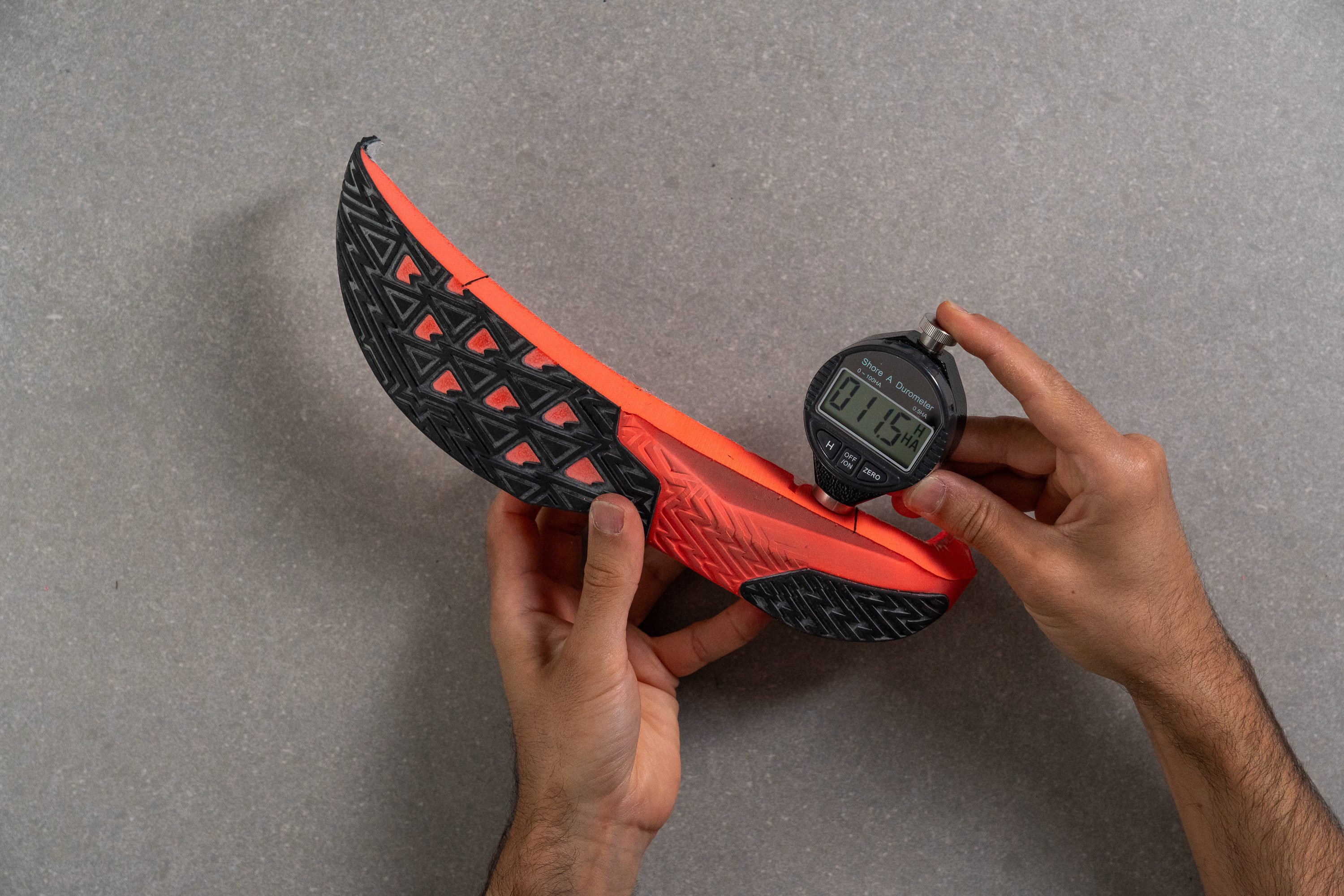
| FuelCell Rebel v5 | 11.5 HA |
| Average | 20.4 HA |
Rocker
The Rebel v4 featured an aggressive rocker that didn’t suit many runners, mainly due to its sharply curved heel. It’s clear New Balance took that feedback seriously because version 5 feels much more dialed in, with a flatter heel and a forefoot curve that begins early but rolls out gradually.
While the previous version was a top pick for midfoot strikers, this update feels more democratic, though we still think it’s a bit less appealing for heel strikers.
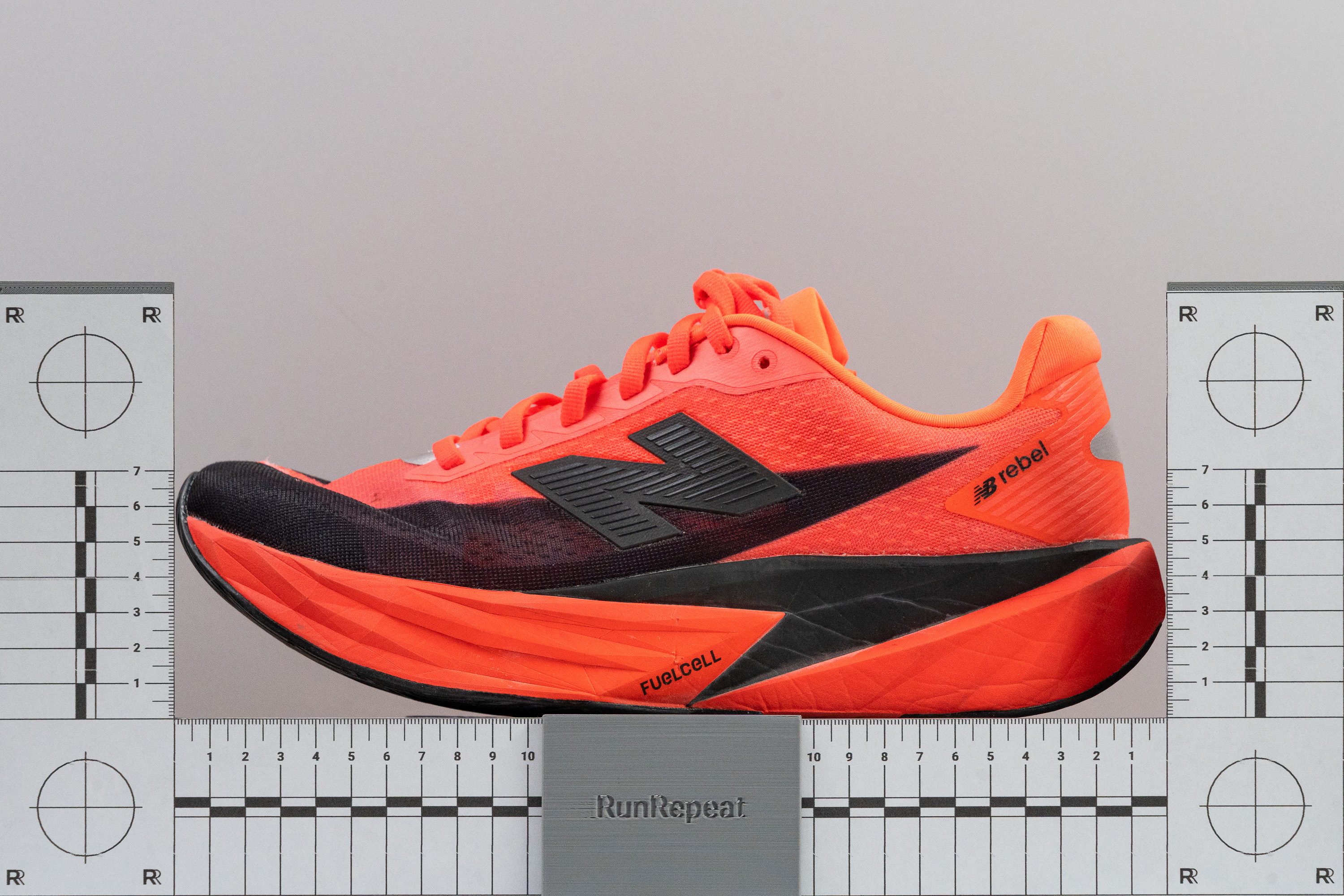
Size and fit
Size
New Balance FuelCell Rebel v5 fits true to size (168 votes).
Width / Fit
After doing both slow and fast runs in the Rebel v5, we discovered it’s still one of the most comfort-focused shoes for tempo efforts. In our view, New Balance really dialed in a runner-friendly fit.
Back in the lab, we measured the width at 96.1 mm, confirming a nice fit that holds the foot securely without feeling tight, striking a near-ideal balance between race-ready lockdown and easygoing comfort.
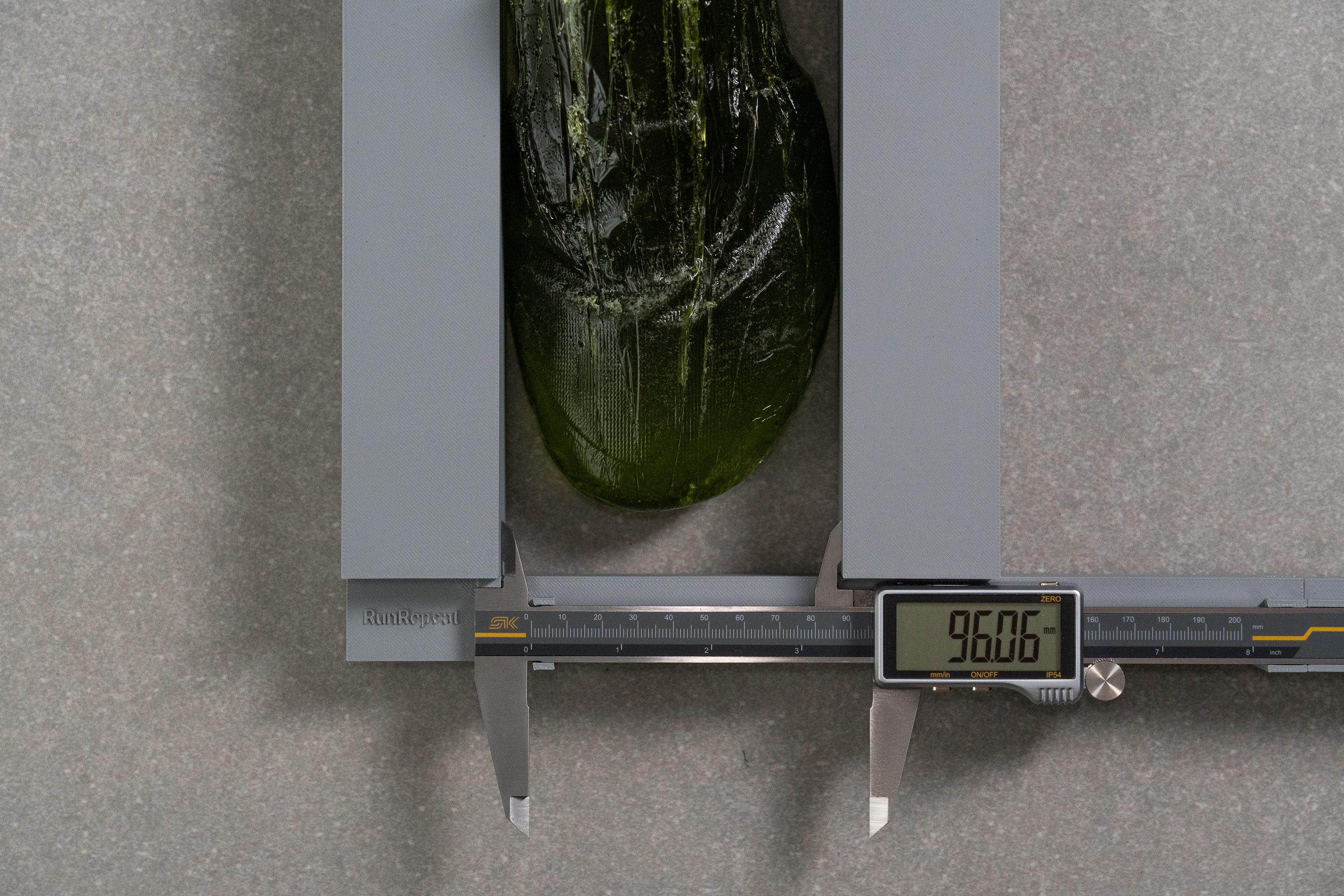
| FuelCell Rebel v5 | 96.1 mm |
| Average | 95.1 mm |
Toebox width
Our second measurement matters even more than the first, as it reveals how the shoe fits in the toebox. At 75.0 mm, there’s generous space up front, definitely enough to keep your toes relaxed.
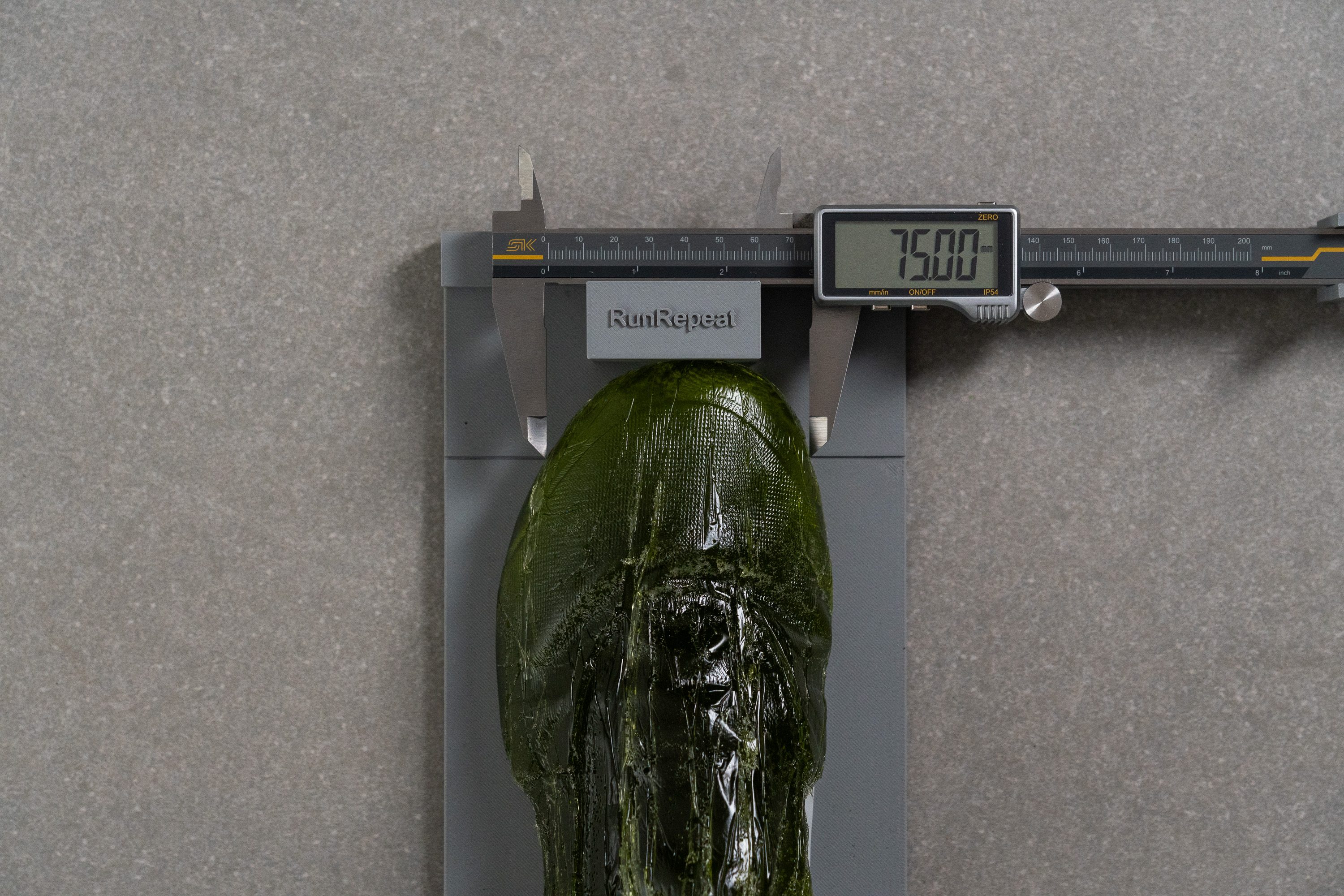
| FuelCell Rebel v5 | 75.0 mm |
| Average | 73.3 mm |
Toebox height
Toebox height checks out as well, offering 27.9 mm of vertical space—more than enough to avoid any pressure on the toes.
And for runners needing a bit of extra wiggle room, the Rebel v5 will be available in wide sizes in select markets.
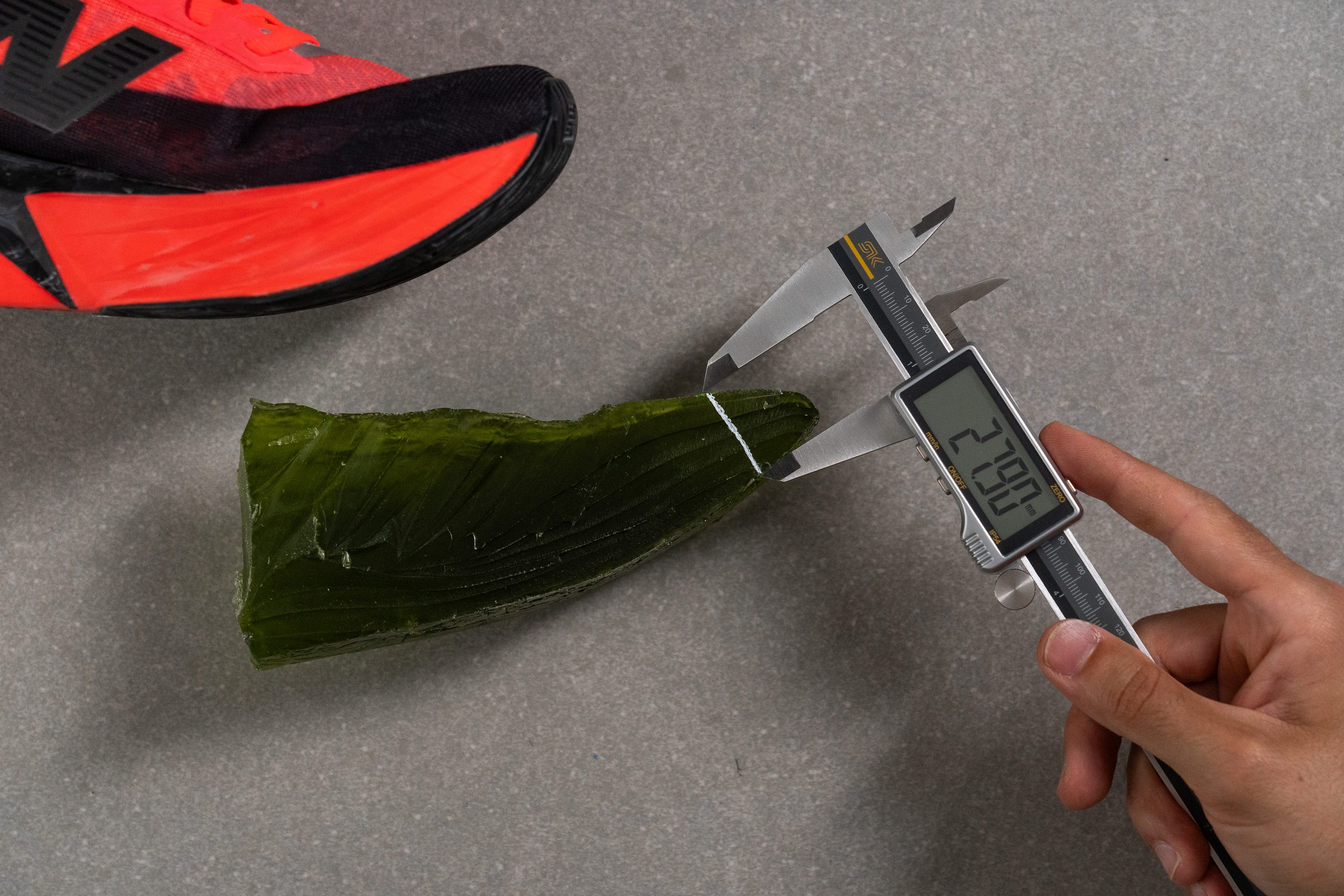
| FuelCell Rebel v5 | 27.9 mm |
| Average | 27.1 mm |
Traction / Grip
Traction test
Traction gets a solid pass from us, delivering dependable grip on both dry and wet surfaces with a 0.50 score in our test. Considering this outsole is designed with weight savings in mind, we see the result as a big win.
| FuelCell Rebel v5 | 0.50 |
| Average | 0.48 |
Outsole design
The forefoot rubber is shaped into small triangular lugs, offering flexibility between grooves. The heel rubber uses a zigzag design for added surface contact, while the foam cutout near the medial heel lightens the structure.
Overall, rubber coverage is focused only on high-wear areas, leaving the midfoot entirely exposed and prioritizing weight savings and flexibility above everything else.
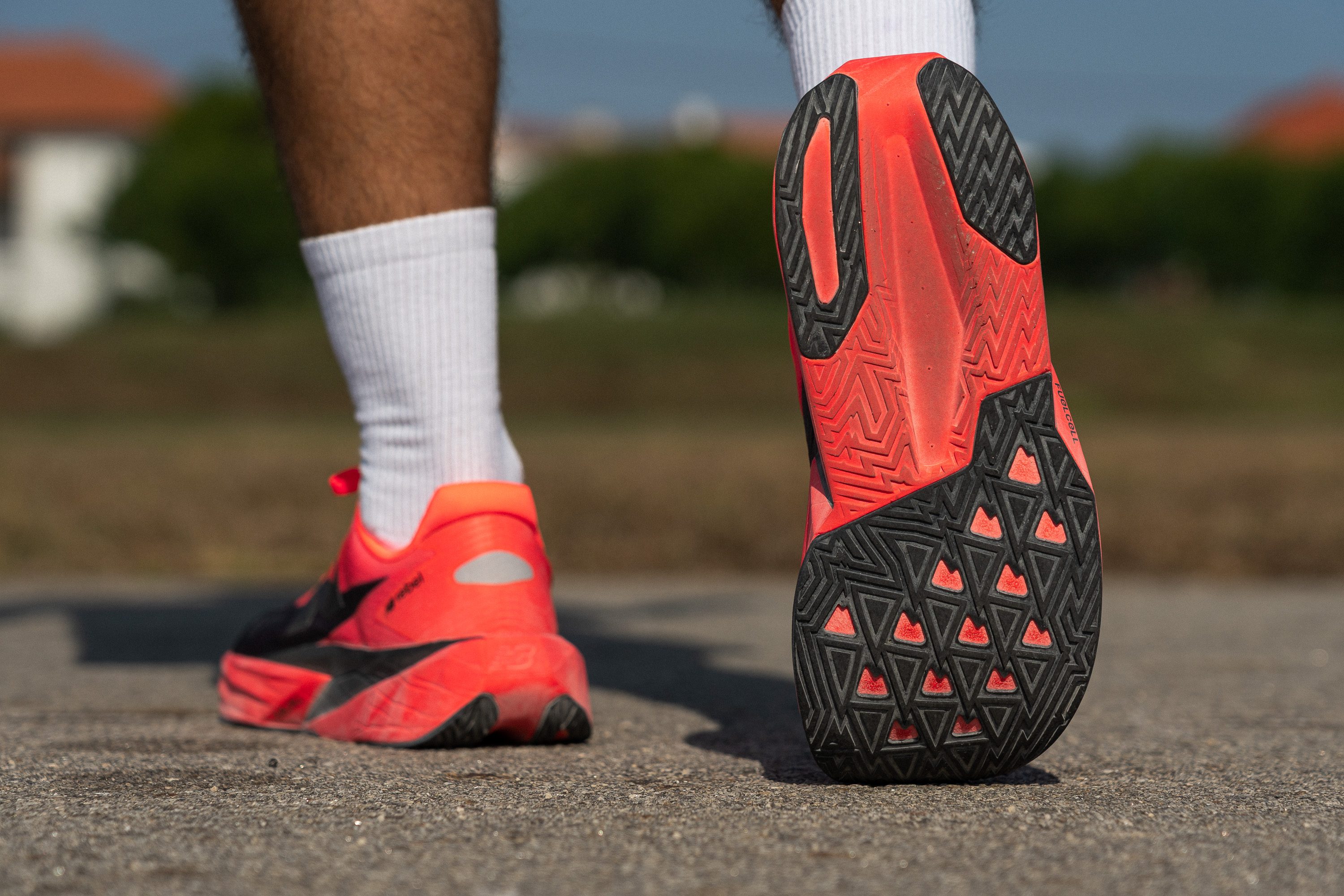
Flexibility / Stiffness
Anyone familiar with the Rebel series knows it’s always been a super-flexible shoe. Thankfully, New Balance kept that identity intact, as our 30-degree bend test measured just 11.7N.
Therefore, we can confirm that the v5 remains impressively comfortable and natural underfoot.
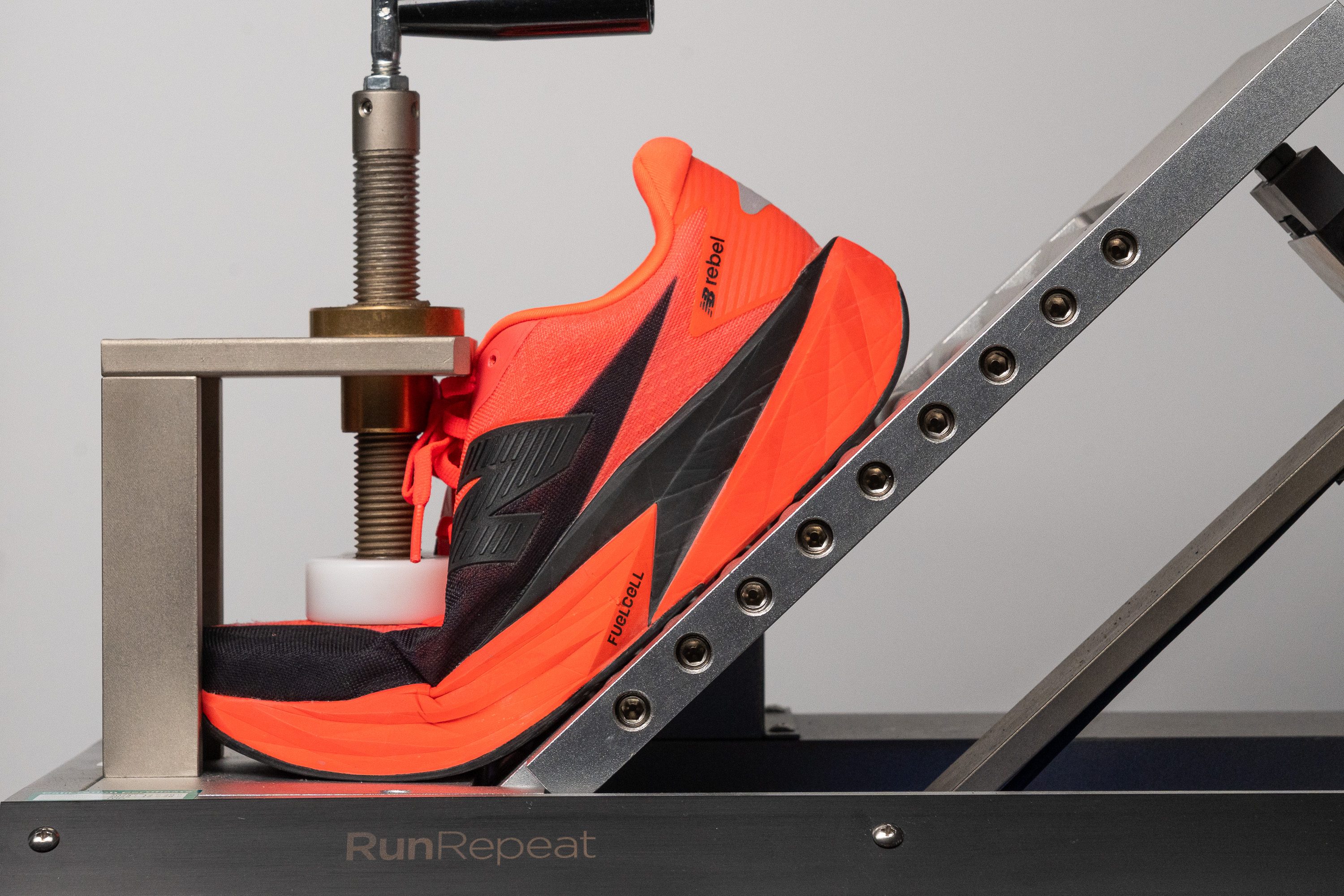
| FuelCell Rebel v5 | 11.7N |
| Average | 15.3N |
Weight
Another standout trait of past Rebel models has always been their lightweight build. Version 5 keeps that legacy alive, coming in at just 7.8 oz or 220g. That's a slight increase from before, but one that makes sense and it's reasonable given the added stack height and comfort.
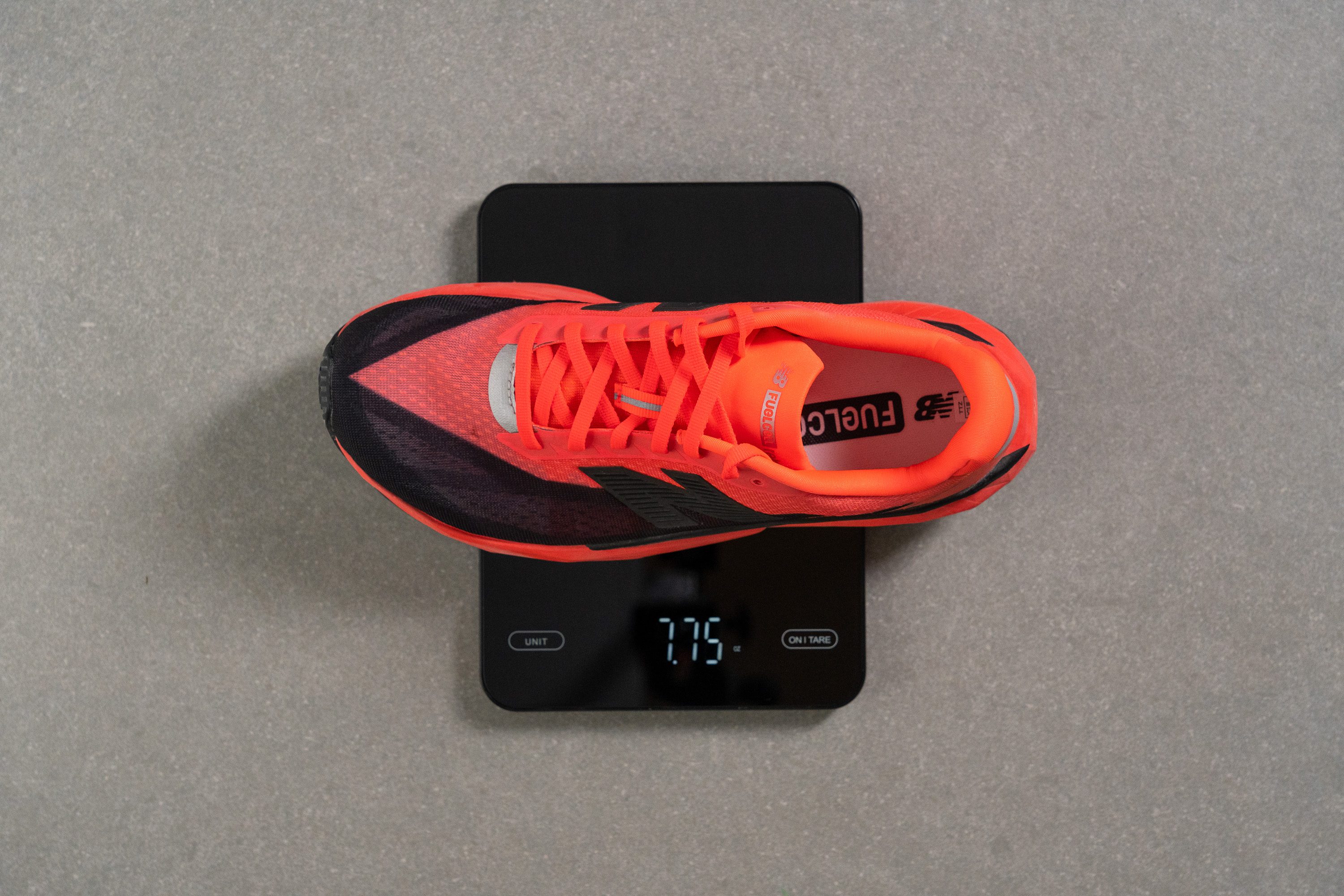
| FuelCell Rebel v5 | 7.8 oz (220g) |
| Average | 9.3 oz (264g) |
Breathability
The Rebel upper has always sparked debate. Version 2 tore easily on the sides and triggered a wave of complaints, while versions 3 and 4 didn’t fit everyone well, mainly due to odd design choices like the heel collar.
Now with version 5, the Rebel finally finds a sweet spot, though we found that breathability could be an issue for some. We gave it a 3/5 for ventilation, which works for most of the year but may feel warm on hot summer days. The difference compared to the more breathable Pacer v2 is quite noticeable in our video.
We also tested the upper over a light to spot airflow zones, and it’s clear New Balance focused ventilation on the toebox while reinforcing the rest of the shoe for added structure and support.
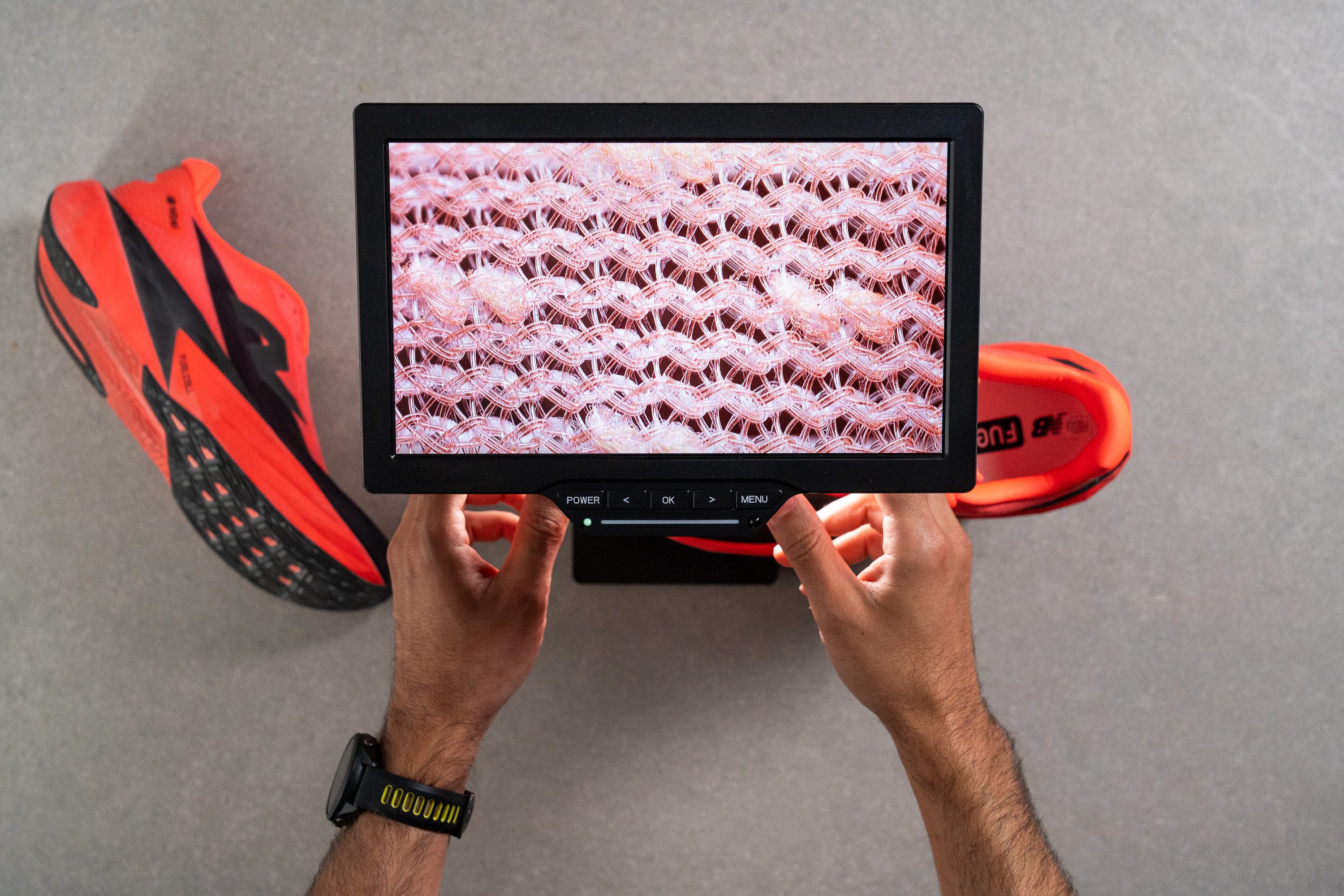
The engineered mesh is lightweight and feels high quality, though its thin build might raise some questions about long-term durability. We'll check that in a minute.
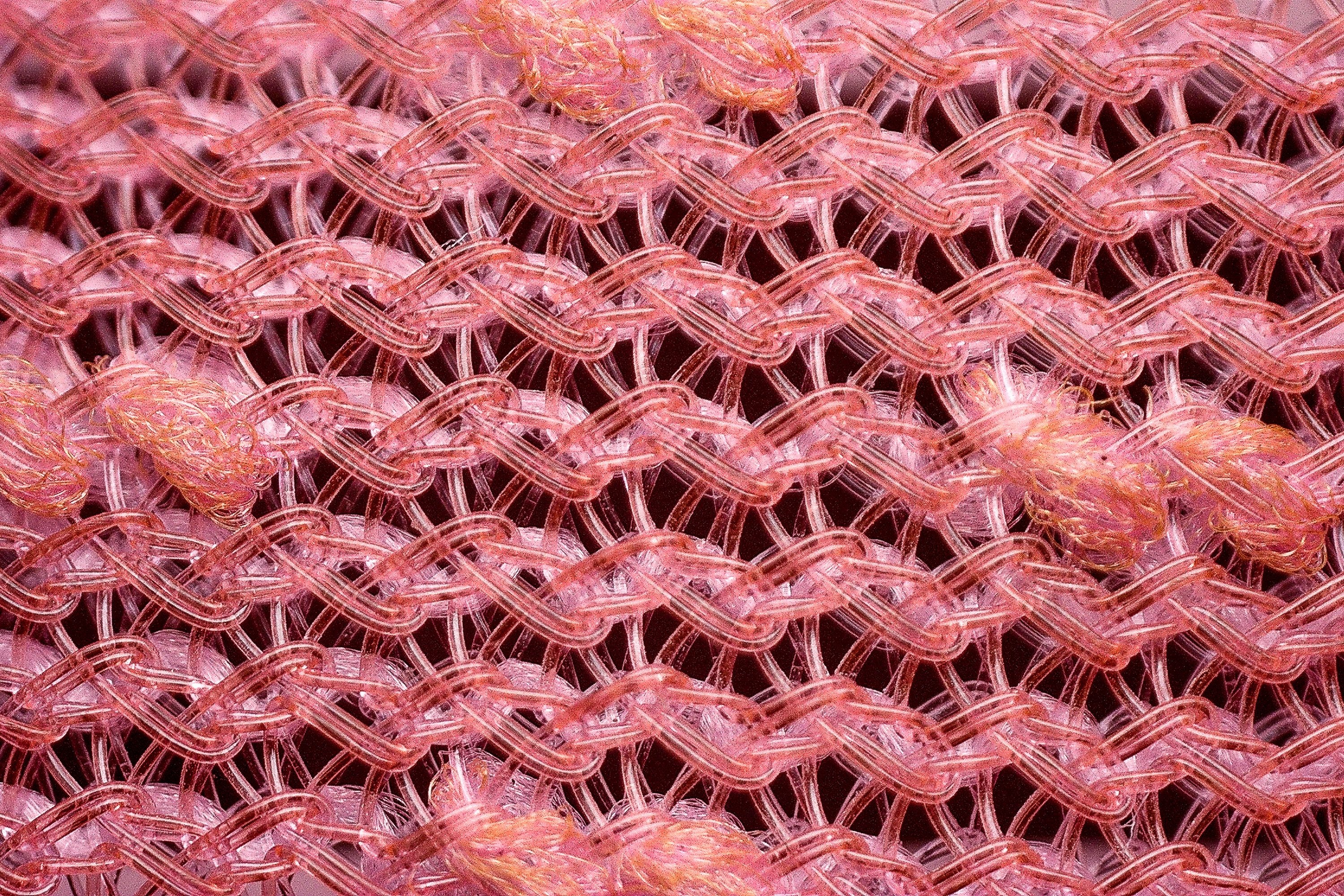
Still, for this price range, it's rare to see an upper this precisely built.
The heel is now extremely padded (unlike version 4) and it feels like New Balance really wanted to make amends. Padding elsewhere is minimal to avoid weight gain, staying true to the Rebel’s light-and-fast design.
| FuelCell Rebel v5 | 3 |
| Average | 3.7 |
Stability
Lateral stability test
The Rebel v5 is a neutral shoe with a few subtle stability elements. It features a wide midfoot, flared sole, and raised midsole sidewalls that help center the ride without feeling bulky or stiff. These features slightly balance the soft foam, but the ride stays smooth and natural.
Torsional rigidity
Torsional rigidity is low at 2/5, playing a key role in the natural ride we’ve described before. This flexibility is also made possible by the limited rubber coverage on the outsole, since more rubber typically leads to a stiffer build.
| FuelCell Rebel v5 | 2 |
| Average | 3.5 |
Heel counter stiffness
The biggest issue with version 4 (it triggered a wave of returns) was the awkward heel counter that pinched the Achilles, similar to what some runners experienced with the Hoka Mach X 2. That’s now resolved, and New Balance also added a bit more structure to this area, earning a 3/5 score more in line with daily trainers.
| FuelCell Rebel v5 | 3 |
| Average | 2.9 |
Midsole width - forefoot
The Rebel v5 appears wider than it actually is, mainly because it skips the usual midfoot taper found in most daily trainers. However, our caliper reading tells the real story: at 114.9 mm in the forefoot, it falls right in line with the average running shoe.
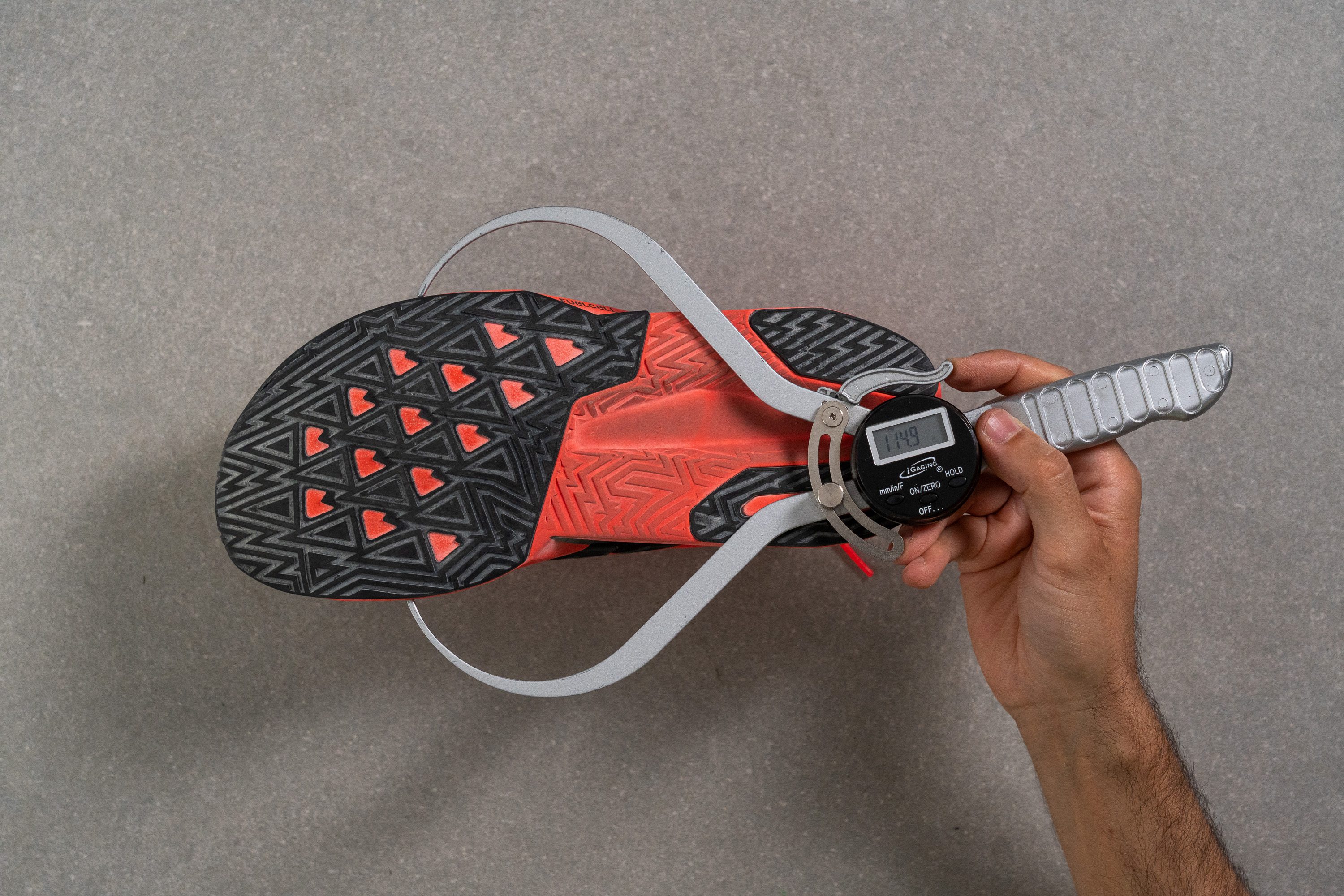
| FuelCell Rebel v5 | 114.9 mm |
| Average | 114.4 mm |
Midsole width - heel
The heel feels similar to the forefoot—visually wide, but our measurement came in at an average 91.4 mm, which keeps the shoe feeling stable without losing agility.
It’s clear that many brands, including New Balance, are now favoring a blocky, rectangle-like shape in the midfoot to boost support.
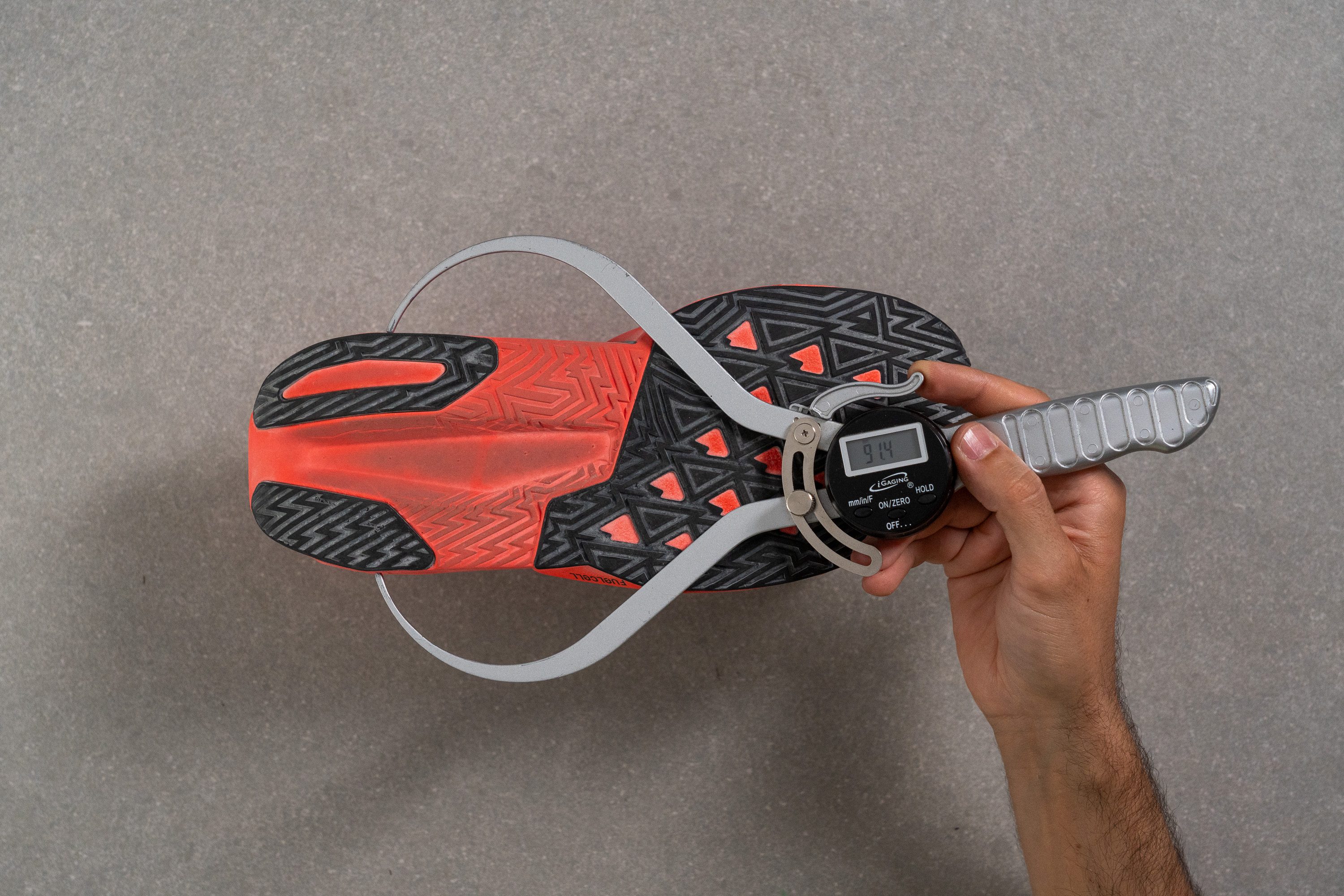
| FuelCell Rebel v5 | 91.4 mm |
| Average | 90.7 mm |
Durability
Toebox durability
We had real concerns about durability after inspecting the upper under the microscope, and our lab test confirmed them. The mesh broke down quickly when exposed to the Dremel, earning the lowest possible score of 1/5.
| FuelCell Rebel v5 | 1 |
| Average | 2.6 |
Heel padding durability
In contrast, the heel padding held up well despite its ultra-plush feel, scoring a strong 4/5 in our durability test. That's definitely a positive result.
| FuelCell Rebel v5 | 4 |
| Average | 3.4 |
Outsole durability
We adjusted our latest Dremel test to account for the rubber’s more abrasion-resistant nature compared to the upper. To match the tougher material, we increased the rotation speed to 10K RPM and extended the duration of the test.
What we found was a 0.8 mm indentation in the outsole, proof that this rubber compound can take a decent beating.
| FuelCell Rebel v5 | 0.8 mm |
| Average | 1.1 mm |
Outsole thickness
New Balance used 3.2 mm of rubber in version 4 but reduced it to 2.6 mm in version 5, likely to balance out the added weight from the increased stack height. Still, we believe this amount is enough for regular daily use.
That said, because of the outsole layout and foam exposure, we’d recommend keeping this shoe strictly on roads.
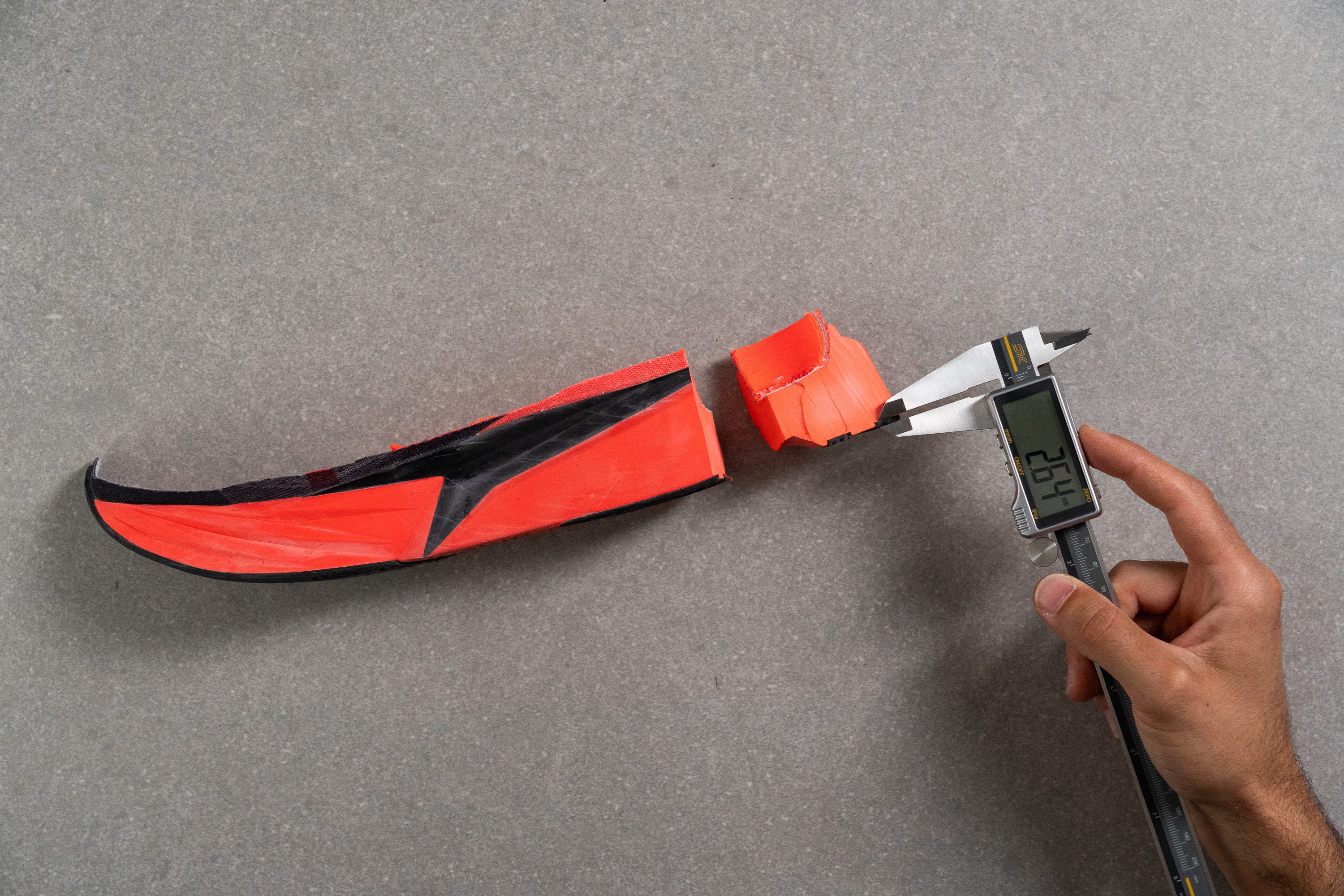
| FuelCell Rebel v5 | 2.6 mm |
| Average | 3.2 mm |
Misc
Insole thickness
The insole is ultra-thin at just 2.6 mm, allowing more direct contact with the underfoot foam. We believe that's an efficient choice for keeping the shoe lightweight and responsive.
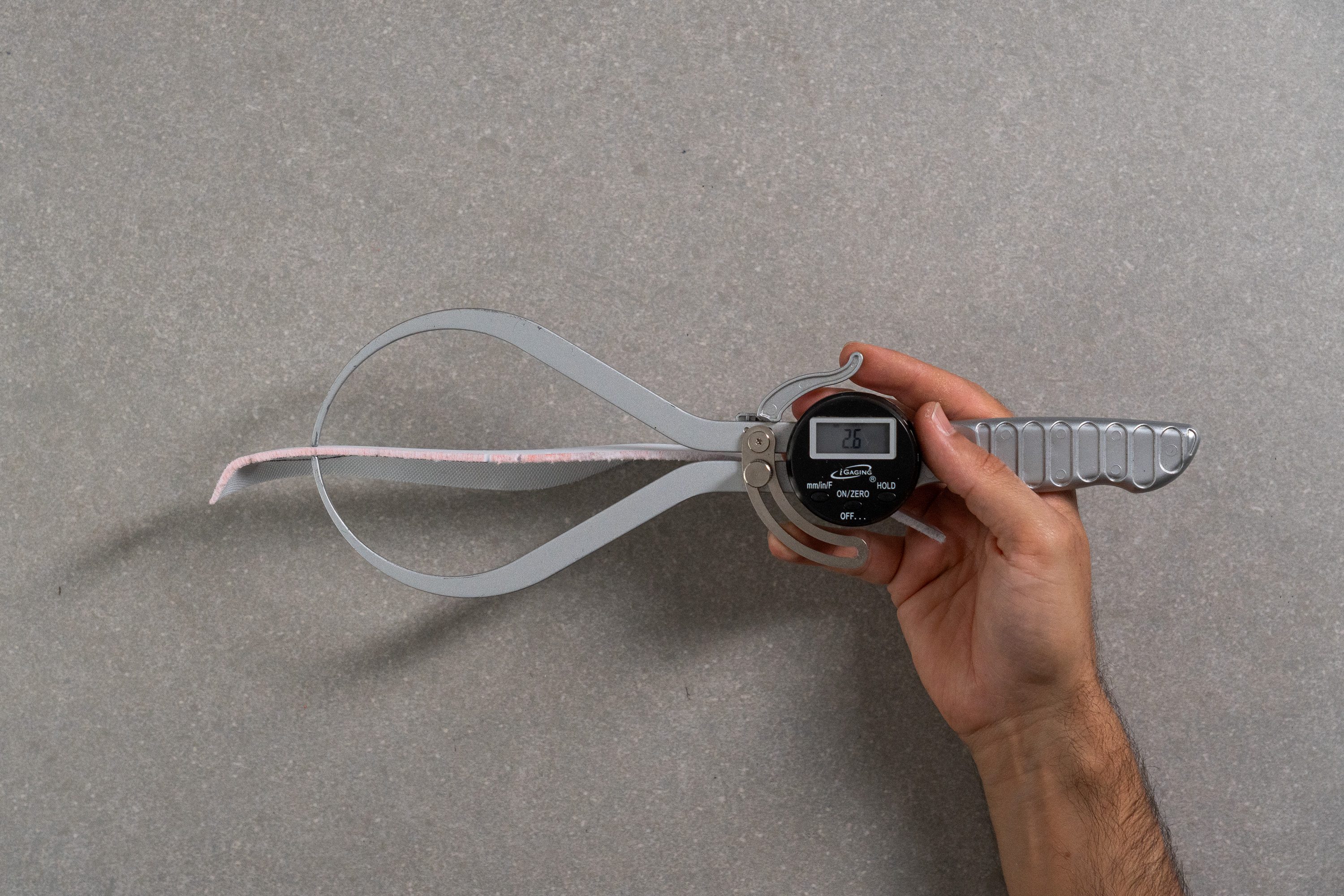
| FuelCell Rebel v5 | 2.6 mm |
| Average | 4.5 mm |
Removable insole
The insole is removable, which let us clearly see its perforated design aimed at shaving off a bit of weight and adding a touch of ventilation.
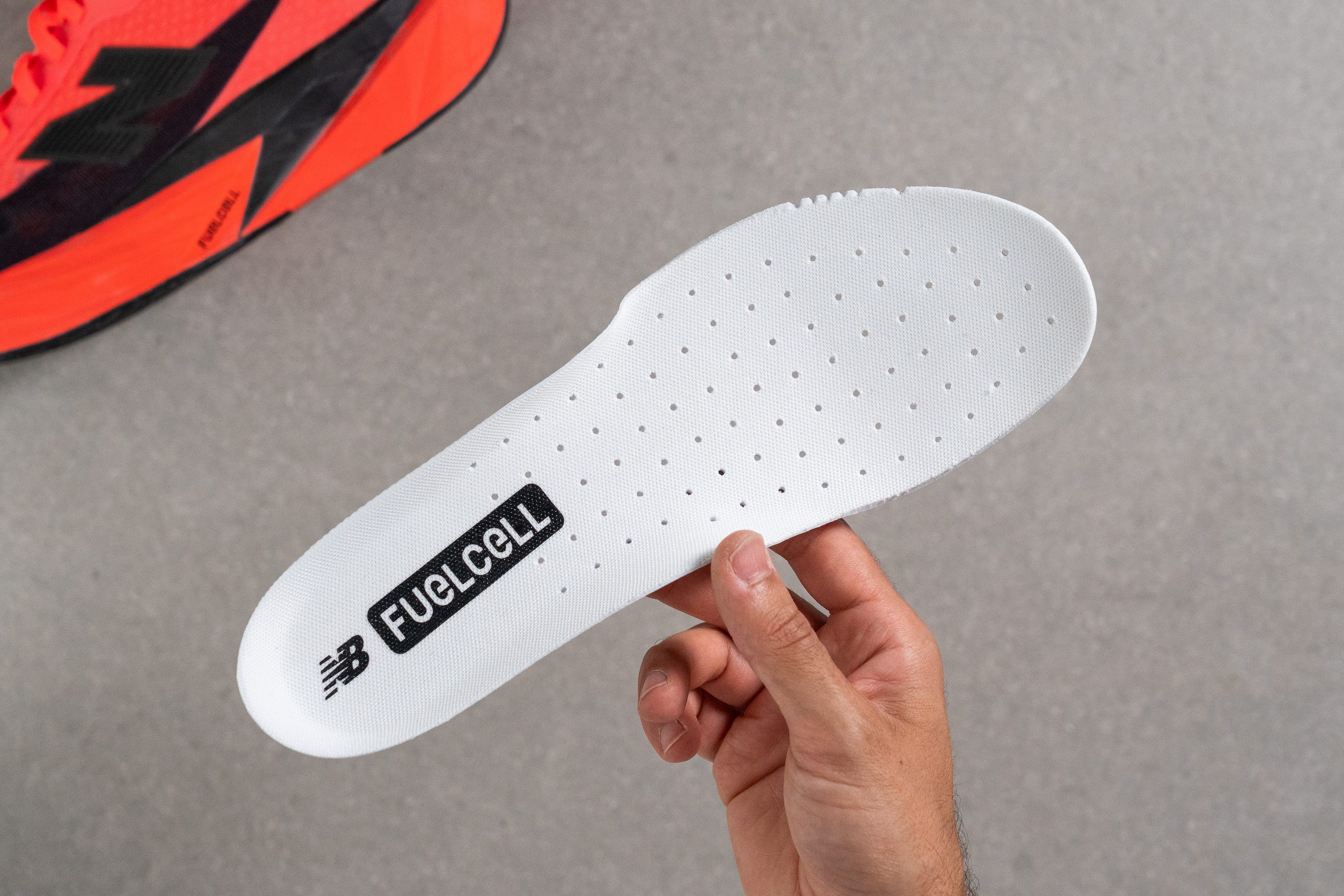
| FuelCell Rebel v5 | Yes |
Midsole softness in cold (%)
One benefit of blending 20% PEBA with 80% EVA as this FuelCell foam does is that PEBA helps offset EVA’s weak performance in cold conditions. Thanks to this mix, we found the foam only got 17% firmer after 20 minutes in the freezer, which is a clear improvement over the average.
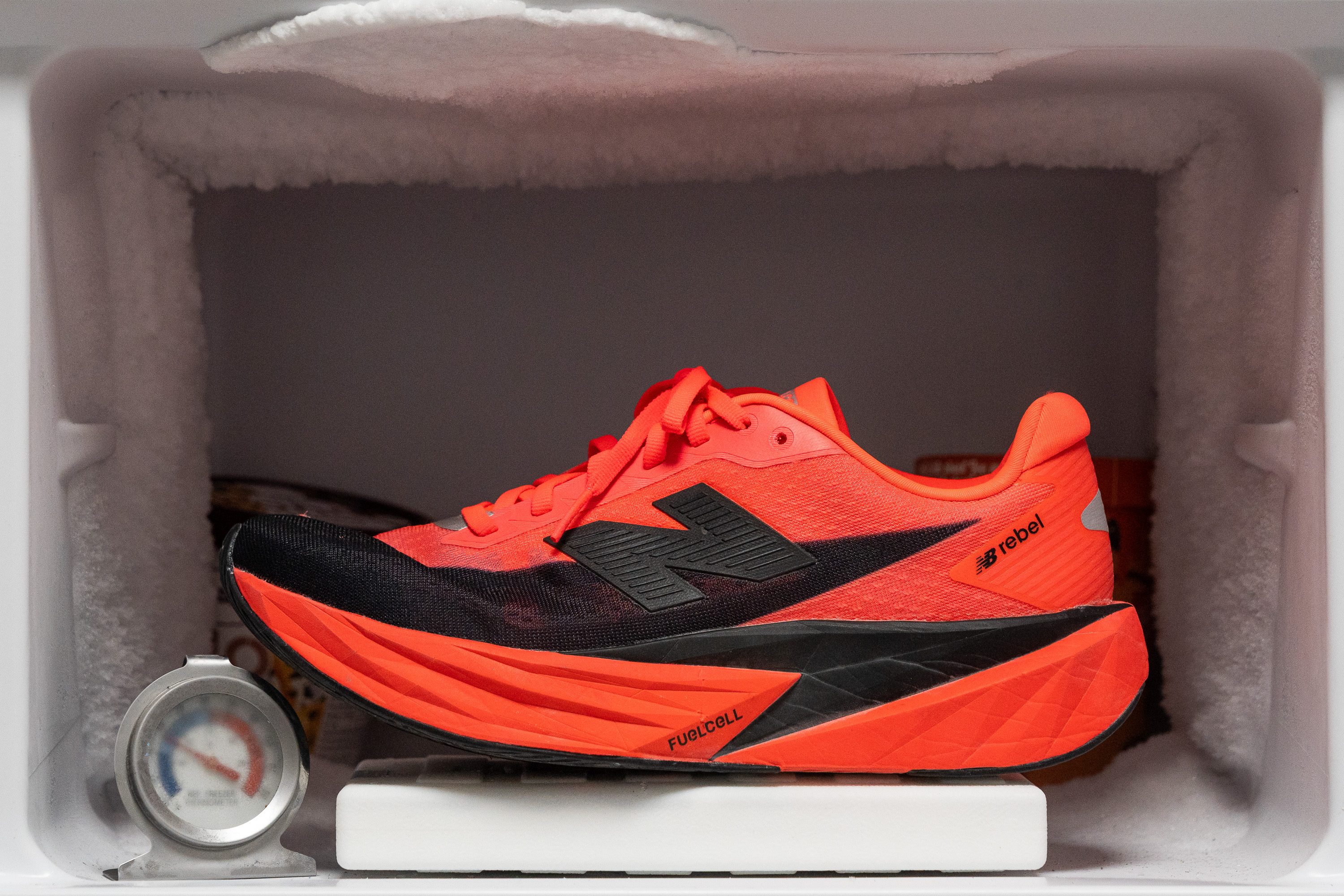
| FuelCell Rebel v5 | 17% |
| Average | 24% |
Reflective elements
We were glad to find reflective elements on the top and back of the Rebel v5. They enhance visibility during night runs, lighting up clearly when hit by headlights.
| FuelCell Rebel v5 | Yes |
Tongue padding
One of the most talked-about design issues in the Rebel v4 was its short tongue, which caused irritation and ruined the fit for many runners.
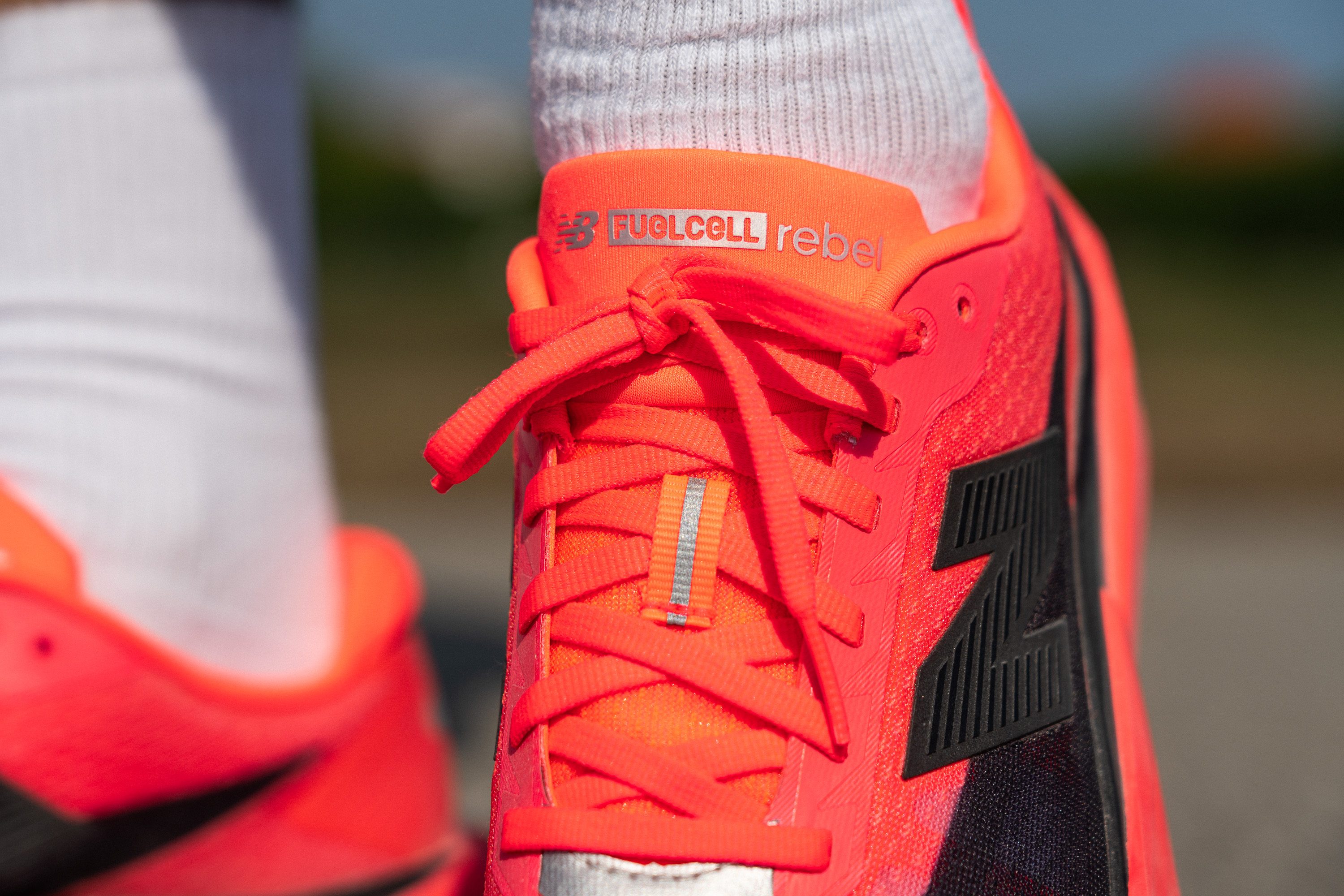
That’s now resolved, as the new version has a better length and fits as expected. We also found a tongue thickness of 2.9 mm, offering light cushioning in the instep without feeling bulky or overbuilt.
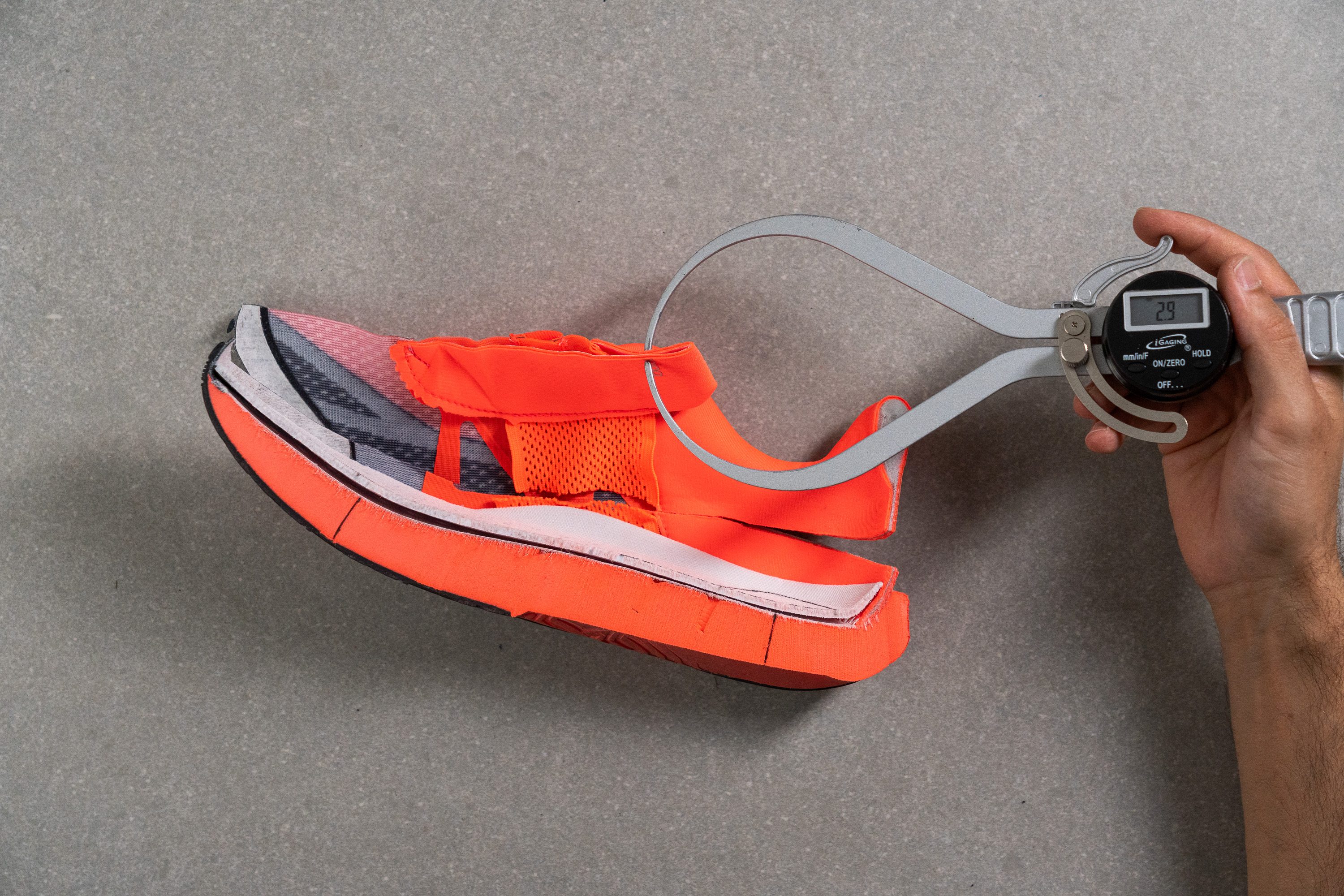
| FuelCell Rebel v5 | 2.9 mm |
| Average | 5.8 mm |
Tongue: gusset type
We found the tongue design to be semi-gusseted, with partial stitching along the sides that keeps it anchored in place. This layout helps prevent the tongue from shifting mid-run.
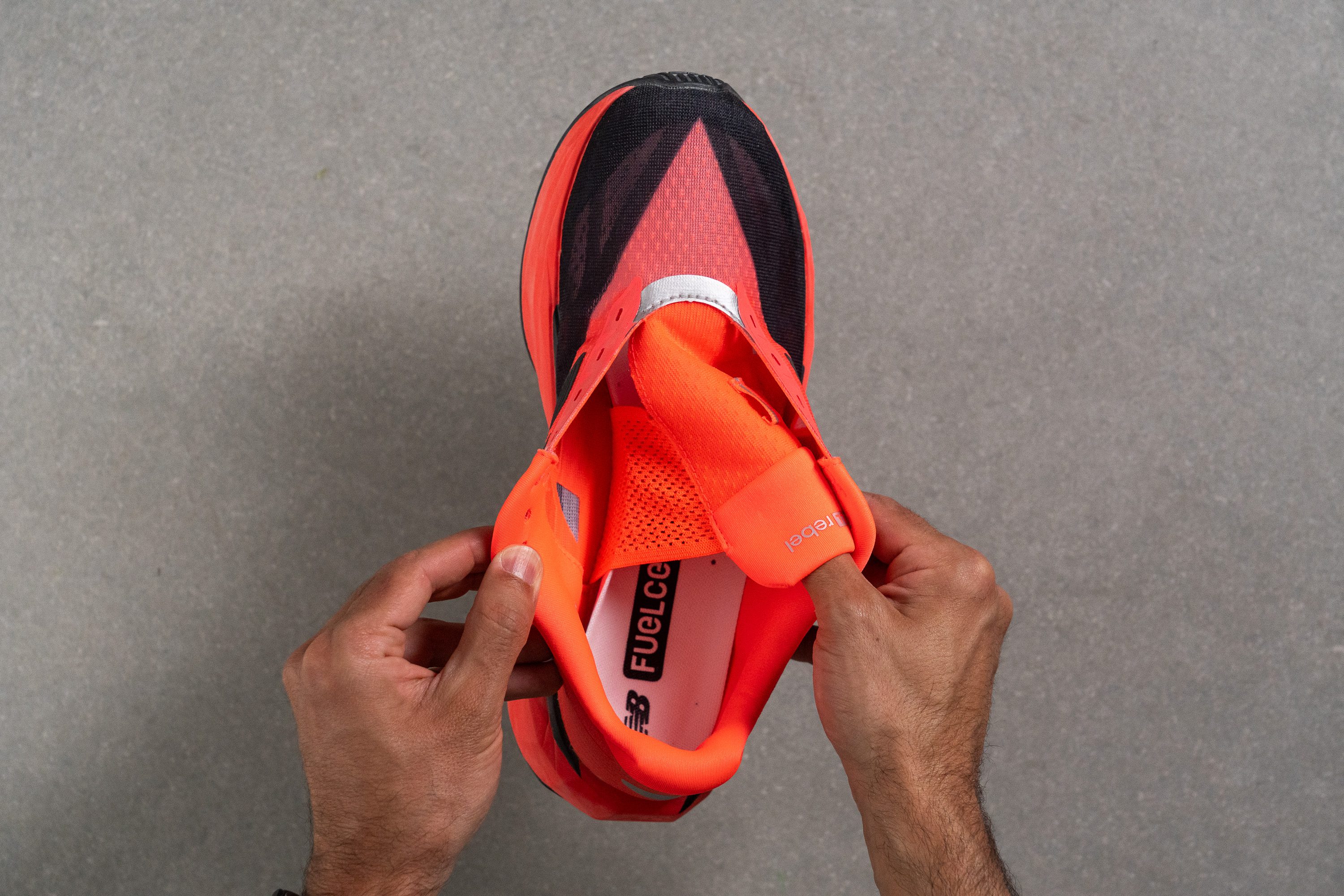
| FuelCell Rebel v5 | Both sides (semi) |
Price
The Rebel v5 avoids a price increase and sticks to the same cost as previous versions, which we see as a big win. For us, it clearly stands out as one of the top options in terms of fun and versatility per dollar.
| FuelCell Rebel v5 | $140 |
| Average | $152 |
Heel tab
The Rebel v5 doesn’t include a heel tab, but that’s consistent with how New Balance has been designing most of its road shoes in recent years.
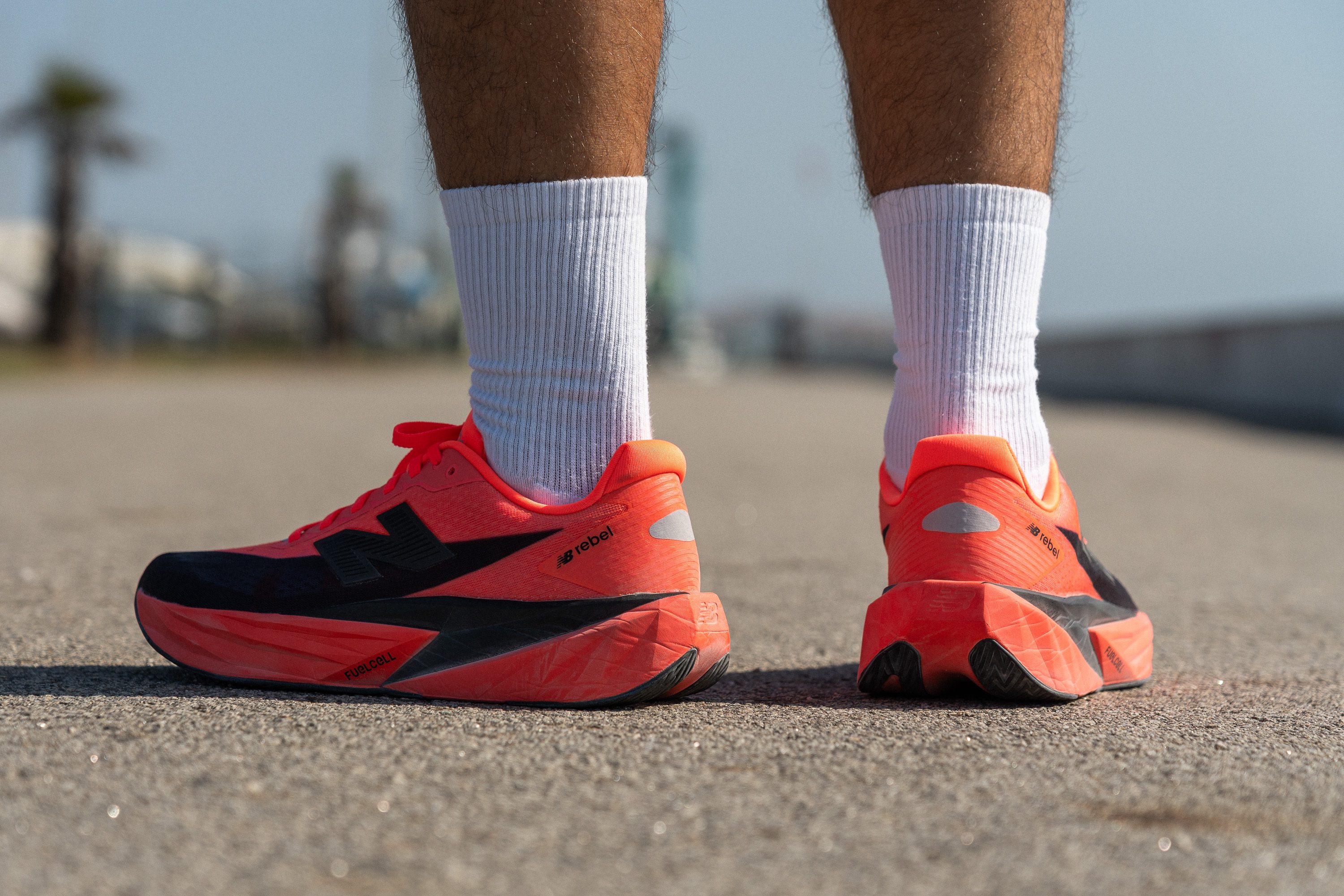
| FuelCell Rebel v5 | None |

